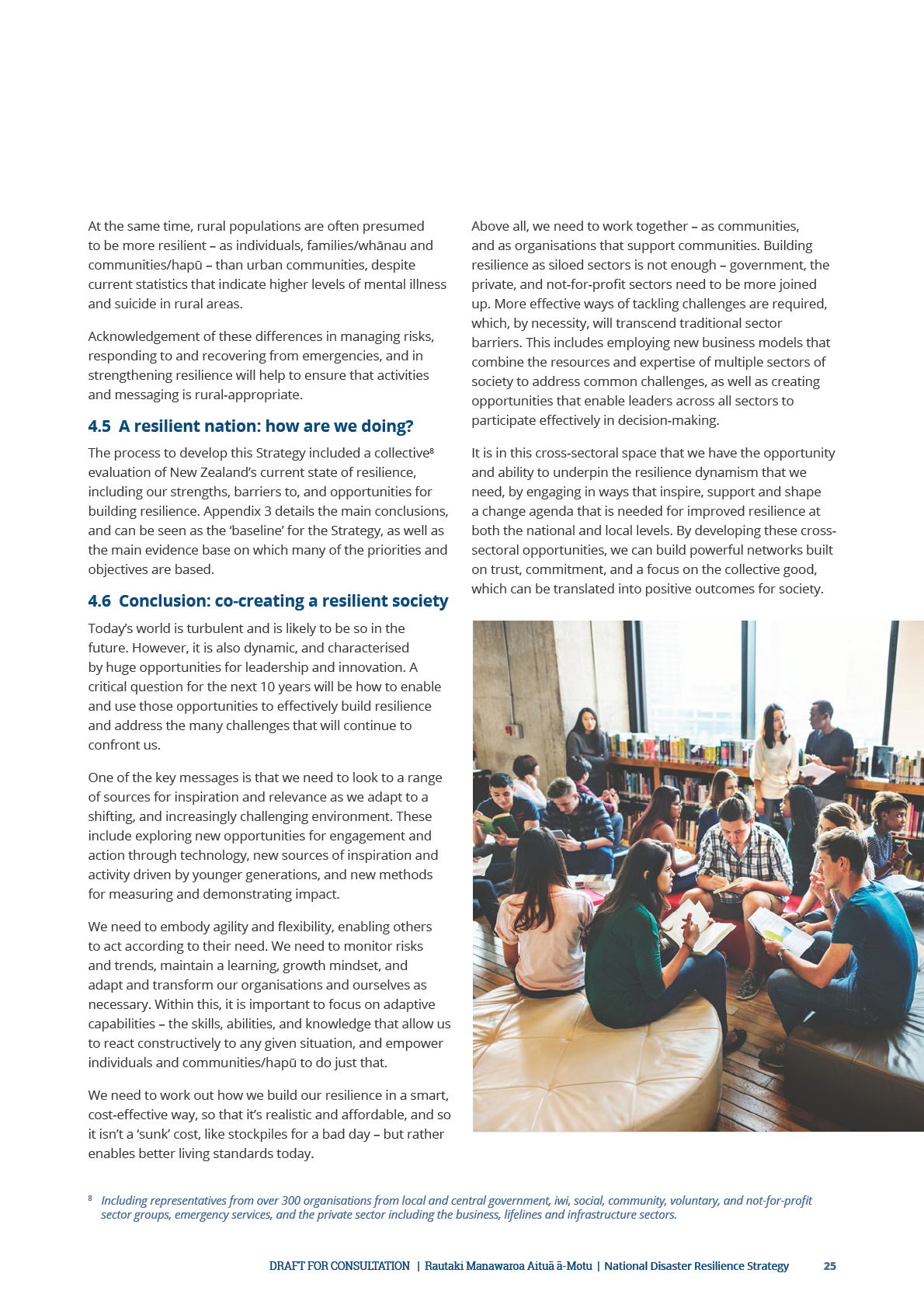
under the Official Information Act 1982
Released
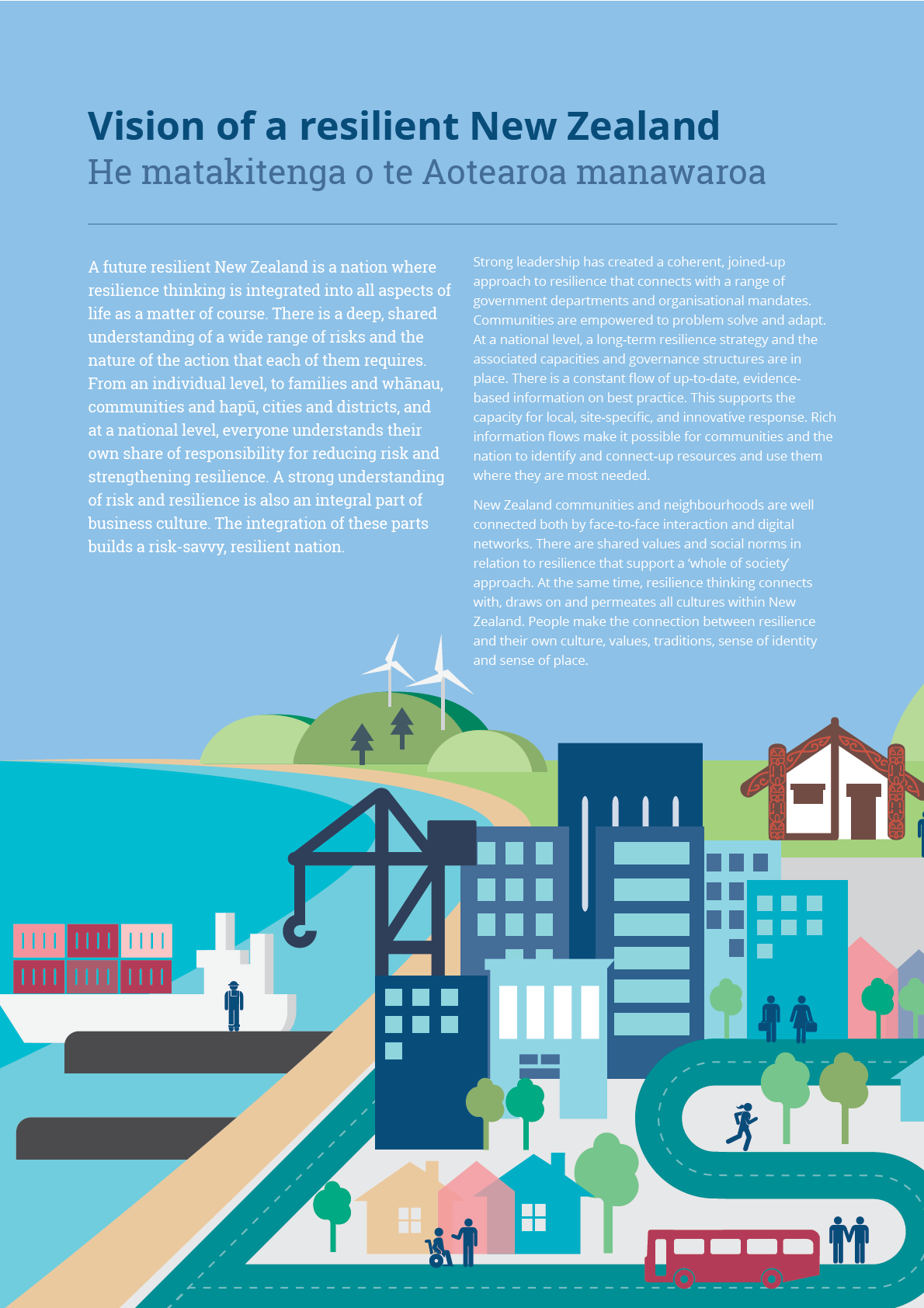
under the Official Information Act 1982
Released
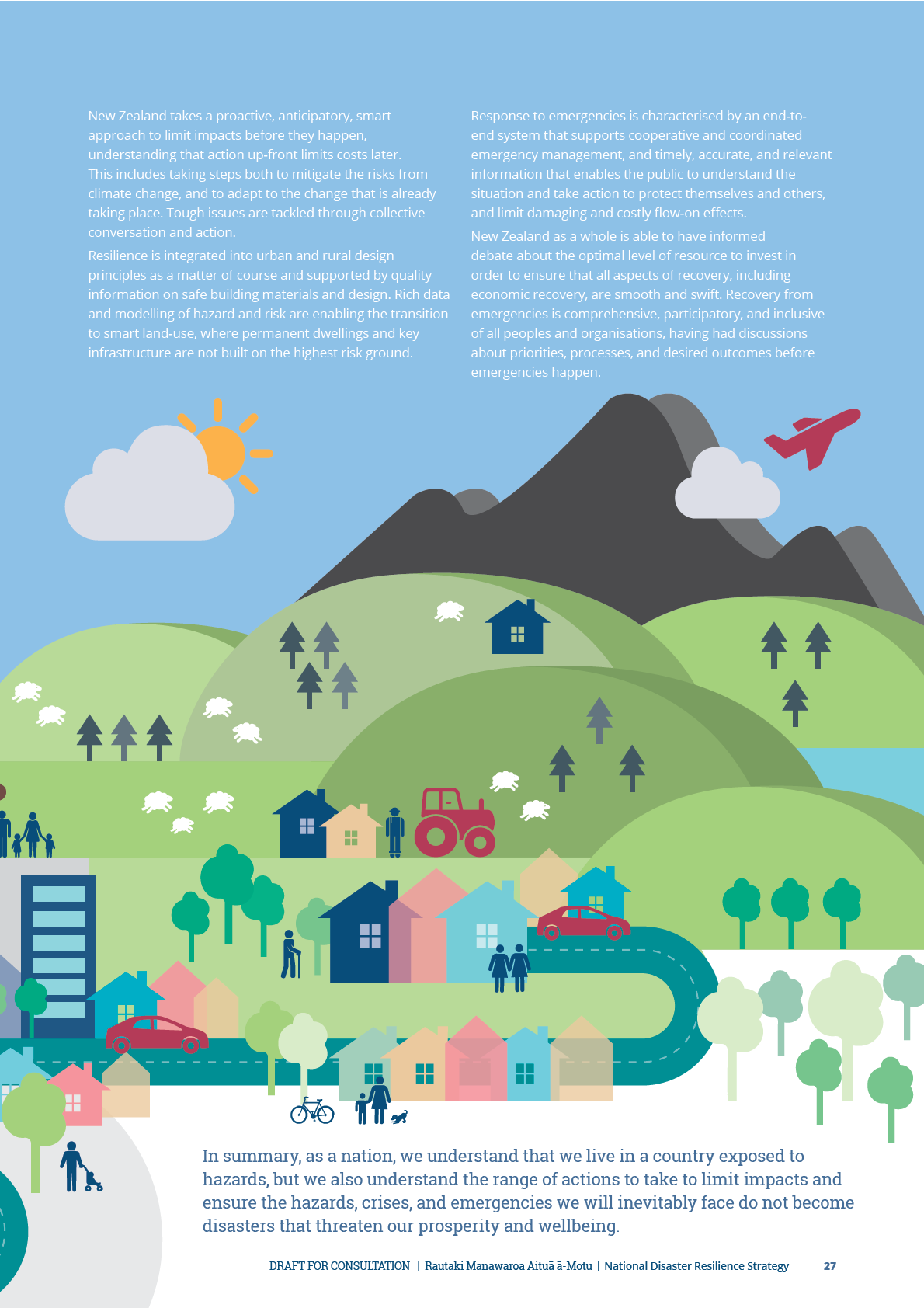
under the Official Information Act 1982
Released
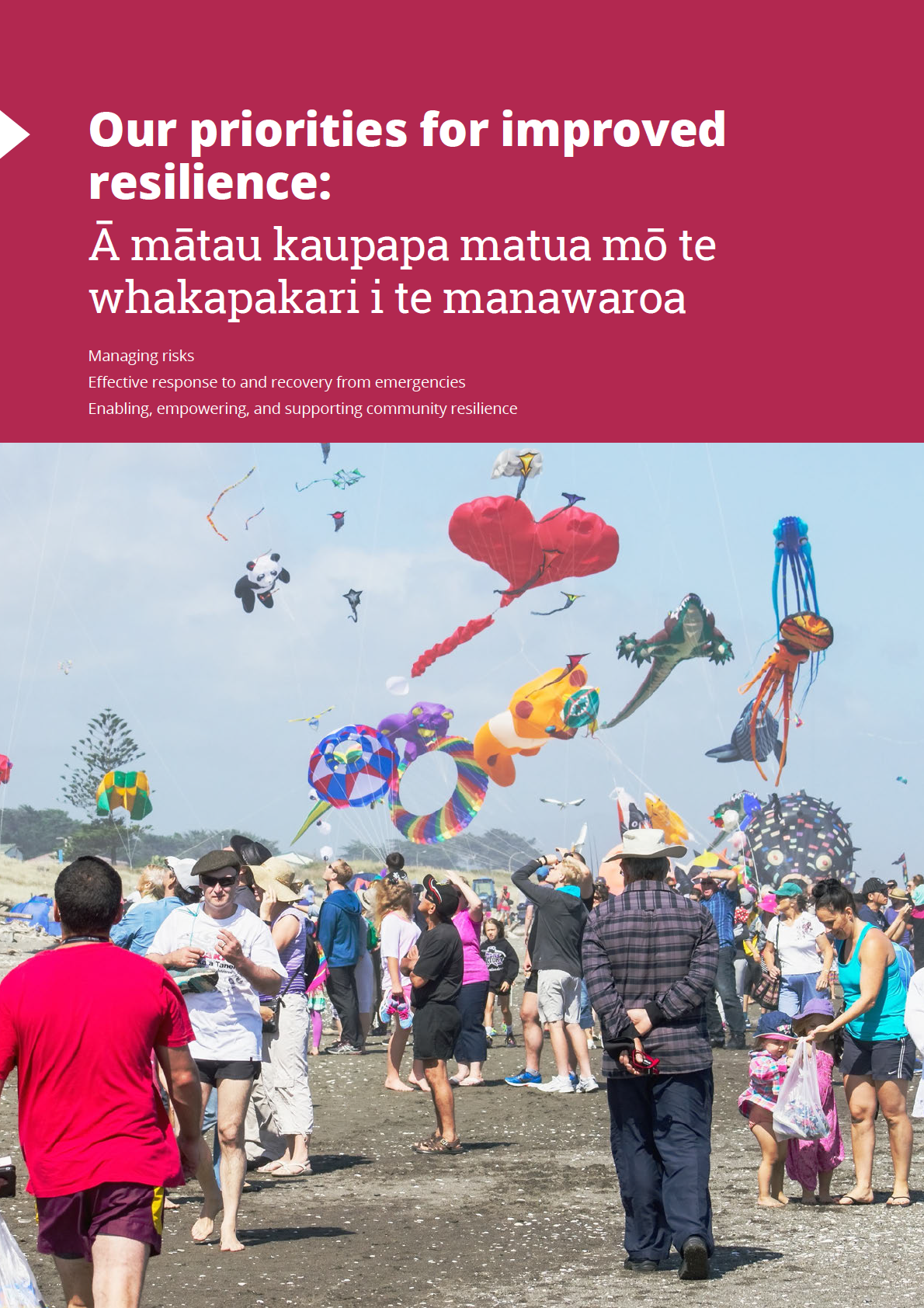
under the Official Information Act 1982
Released
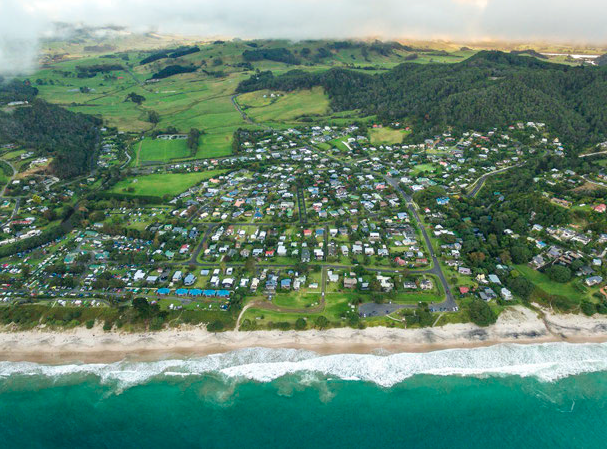 5. Managing risks
5. Managing risks
Te whakahaere mōrea
What we want to see: New Zealand is a risk savvy nation that takes all practicable
steps to identify, prioritise, and manage risks that could impact the wellbeing and
prosperity of New Zealanders, and all who live, work, or visit here.
This priority is concerned with identifying and monitoring
In the construction sector, quantifying the potential risk
risks to our wellbeing, taking action to reduce our existing
expected in the lifetime of a building, bridge, or other
levels of risk (‘corrective risk management’), minimise
critical infrastructure drives the creation and modification
the amount of new risk we create (‘prospective risk
of building codes. In the land-use and urban planning
management’), and ensuring that everyone has the data,
sectors, robust analysis of flood (and other) risk likewise
information, knowledge, and tools they need to be able to
drives investment in flood protection and possibly effects
make informed decisions about resilience.
changes in insurance as well. In the insurance sector, the
quantification of disaster risk is essential, given that the
We have seen how we already have a considerable amount
solvency capital of most insurance companies is strongly
of risk in our society through the hazards we face, the assets
influenced by their exposure to risk.
we have exposed to those hazards, and the vulnerability of
people, assets, and services to impacts. It is important for
A critical part of understanding and managing risk is
us to try and reduce that level of existing risk so that the
understanding the full range of costs involved in disasters,
chances of disaster are reduced, and/or the impacts are
both the direct costs from damage and the more indirect
reduced if or when hazardous events occur.
and intangible costs resulting from flow-on effects and
social impact. We also need to identify the range of financial
At the same time, it is critical to recognise how we
instruments that may be available to support the activities
inadvertently add to that risk through poor development
designed to reduce our risk and build our resilience,
choices, including land-use and building choices. Planning
including those promoted in this Strategy.
for resilience at the outset of new projects is by far the
cheapest and easiest time to minimise risk and has the
potential to significantly reduce disaster costs in the future.
Risk information provides a critical foundation for managing
disaster risk across all sectors. At the community level,
an understanding of hazard events—whether from
living memory or oral and written histories— can inform
under the Official Information Act 1982
and influence decisions on preparedness, including
life-saving evacuation procedures and the location of
important facilities.
Released
DRAFT FOR CONSULTATION | Rautaki Manawaroa Aituā ā-Motu |
National Disaster Resilience Strategy 29
The six objectives designed to progress the priority of managing risks are at all levels to:
Objective
What success looks like; by 2030:
1 Identify and understand risk scenarios
There is an agreed, standardised, and widely-used methodology for
(including the components of hazard,
assessing disaster risks at a local government, large organisation,
exposure, vulnerability, and capacity),
and central government level. This includes making use of scientific,
and use this knowledge to inform
indigenous, and local knowledge. Risks can be aggregated and viewed
decision-making
at a national or sub-national level, and the results inform the risk
assessment efforts of others. Businesses and small organisations
can make use of a simplified version to assess their own risks, and
make decisions about courses of action. Particular attention is paid
to assessing and reducing the vulnerability of people and groups,
including to take an inclusive, participatory approach to planning and
preparedness.
2 Put in place organisational structures
The governance of risk and resilience in NZ is informed by multi-
and identify necessary processes -
sectoral views and participation including the private sector, not-
including being informed by community for-profit, and other community representatives. Progress on risk
perspectives - to understand and act on
management and towards increased resilience is publicly tracked, and
reducing risks
interventions evaluated for effectiveness.
3 Build risk awareness, risk literacy, and
There is an agreed ‘plain English’ lexicon for risk, including better visual
risk management capability, including
products for describing the risk of any situation, hazard, product, or
the ability to assess risk
process; government agencies and science organisations regularly
communicate with the public about risks in a timely and transparent
manner, and in a way that is understandable and judged effective by
the public. This transparency of risk information leads to more inclusive
conversations on the acceptability of risk.
4 Address gaps in risk reduction policy
We have had a national conversation – including with affected and
(particularly in the light of climate
potentially-affected communities – about how to approach high hazard
change adaptation)
areas, and we have a system level-response (including central and local
government) with aligned regulatory and funding/financing policies in
place.
5 Ensure development and investment
Communities value and accept having resilience as a core goal for
practices, particularly in the built
all development, recognising that this may involve higher upfront
and natural environments, are risk-
costs though greater net benefits in the long term; plans, policies and
aware, taking care not to create any
regulations are fit for purpose, flexible enough to enable resilient
under the Official Information Act 1982
unnecessary or unacceptable new risk
development under a variety of circumstances, and can be easily
adapted as risks become better understood; developers aim to exceed
required standards for new development, and may receive appropriate
recognition for doing so; earthquake prone building remediation meets
required timeframes and standards.
6 Understand the economic impact of
There is an improved understanding of the cost of disasters and
disaster and disruption, and the need
disruption, including the economic cost of social impact; we are
for investment in resilience; identify
routinely collecting data on disruption, and using it to inform decision-
Released
and develop financial mechanisms that
making and investment in resilience; there is a clear mix of funding and
support resilience activities
incentives in place to advance New Zealand’s disaster risk management
priorities and build resilience to disasters.
30 National Disaster Resilience Strategy | Rautaki Manawaroa Aituā ā-Motu | DRAFT FOR CONSULTATION
 6. Effective response to and recovery
from emergencies
6. Effective response to and recovery
from emergencies
Te urupare tōkita me te whakaora
mai i ngā ohotata
What we want to see: New Zealand has a seamless end-to-end emergency
management system that supports effective response to and recovery from
emergencies, reducing impacts, caring for individuals, and protecting the long-
term wellbeing of New Zealanders.
Responding to, and recovering from, disasters remains
There are many strengths in New Zealand’s emergency
– and may always remain – our toughest challenge. This
management system. Our system is set up to deal with
is when we have most at risk, when human suffering is
‘all hazards and risks’, we work across the ‘4Rs’, and
potentially at its greatest, and when there is most threat to
engage communities in emergency management. There is
our property, assets, and economic wellbeing.
passion and commitment from all those who respond to
emergencies, paid staff, volunteers, and communities alike.
The response phase can involve frenetic pace, confusion,
pressure, and has the highest requirement for good
In recent years, significant global and local events have
decision-making and effective communications. Recovery
changed how we think about emergency management.
can be the most complex, requiring inclusive and
The Canterbury earthquakes are still fresh in our minds
participatory approaches, reflection and careful planning,
as a nation. A changing climate means we could get more
but needs to be balanced with a need for momentum and
frequent storms and floods. Globally, we see the impact
progress.
of tsunami, pandemics, industrial accidents, terrorism
incidents and other hazards that cause serious harm
Both hold the opportunity to minimise impacts before
to people, environments, and economies. Our risks are
they get out of control, to limit the suffering of individuals,
changing. Our emergency management system must
families/whānau, communities and hapū, to manage risk
change too to ensure it works when we need it.
and build in resilience for an improved future.
This priority aims to further progress the advancements
we have made in responding to and supporting recovery
from emergencies over the last 16 years since the CDEM Act
under the Official Information Act 1982
came into effect. It incorporates the Government’s decisions
on the Review into
Better Responses to Natural Disasters and
Other Emergencies (2017), and it looks at the next generation
of capability and capacity we require. It aims to modernise
the discipline of emergency management and ensure
we are ‘fit-for-purpose’, including to address some of the
emerging issues of maintaining pace with media and social
media, responding to new and complex emergencies,
enabling and empowering all-of-society participation, and
the type of command, control, and leadership required
Released
to ensure rapid, effective, inclusive, and compassionate
response and recovery.
DRAFT FOR CONSULTATION | Rautaki Manawaroa Aituā ā-Motu |
National Disaster Resilience Strategy 31
The six objectives designed to progress the priority of effective response to and recovery from emergencies are to:
Objective
What success looks like; by 2030:
7 Ensure that the safety and wellbeing of
There is renewed levels of trust and confidence in the emergency
people is at the heart of the emergency
management system. In emergencies, the safety, needs, and wellbeing of
management system
affected people are the highest priority. The public know what is going on,
what to expect, and what to do: hazard warnings are timely and effective,
and incorporate new technology and social science; strategic information
is shared with stakeholders, spokespeople, and the media, so they get
the right advice at the right time; and public information management is
resourced to communicate effectively with the public, through a variety
of channels, in formats that are sensitive to the needs of the most
vulnerable.
8 Build the relationship between
There is good collaboration and coordination between iwi and emergency
emergency management organisations
management agencies in relation to emergency management.
and iwi/groups representing Māori,
Engagement with iwi recognises the mana and status of Māori as tangata
to ensure greater recognition,
whenua, and provides practical commitment to the Treaty of Waitangi,
understanding, and integration of iwi/
including the principles of partnership, participation, and protection.
Māori perspectives and tikanga in
Iwi are represented on Coordinating Executive Groups and provide
emergency management
advice in relation to governance and planning. CDEM Groups work with
marae in their region that want to have a role in response and recovery,
to understand their tikanga, support planning and development of
protocols, and establish clear arrangements for reimbursement of
welfare-related expenses.
9 Strengthen the national leadership of
There is more directive leadership of the emergency management
the emergency management system
system, including setting national standards for emergency management,
so there is a consistent standard of care across the country. There is
strengthened stewardship of the system, including a clear understanding
of, and arrangements for, lead and support roles for the full range of
national risks.
10 Ensure it is clear who is responsible for
Legislative and policy settings support plans at all levels that are clearer
what, nationally, regionally, and locally,
about how agencies will work together and who will do what. Updated
in response and recovery; empower
incident management doctrine provides clarity about roles and functions,
and enable community-level response,
and is used by all agencies to manage all events. At a regional level,
and ensure it is connected into wider
shared service arrangements are clear about local and regional roles,
coordinated responses, where necessary and mean better use of resources and better holistic service delivery
to communities. Communities, including the private and not-for-profit
sectors, are empowered to problem-solve and lead their own response
and recovery, while having connections into official channels to source
under the Official Information Act 1982
support and resources where needed.
11 Build the capability and capacity of the
All Controllers and Recovery Managers are trained and accredited; people
emergency management workforce for
fulfilling incident management roles have the appropriate training,
response and recovery
skills, experience and aptitude and volunteers are appropriately trained,
recognised, and kept safe in the system. Fly-in Teams undertake rapid
deployments in emergency response and recovery situations to support
local capability and capacity. The broader emergency management
workforce has increased competency in matters of diversity and
inclusiveness, including cultural competence, and disability-inclusive
Released
approaches.
12 Improve the information and
All stakeholders in the emergency management system have access to
intelligence system that supports
the same operational and technical information, which provides greater
decision-making in emergencies
awareness of the situation at hand, and allows timely and effective
decision-making.
32 National Disaster Resilience Strategy | Rautaki Manawaroa Aituā ā-Motu | DRAFT FOR CONSULTATION
 7. Enabling, empowering, and supporting
community resilience
7. Enabling, empowering, and supporting
community resilience
Te whakapakari i te manawaroa o te iwi
What we want to see: New Zealand has a culture of resilience that means
individuals and families/whānau, businesses and organisations, communities
and hapū are empowered to take action to reduce their risks, connect with others,
and build resilience to shocks and stresses.
This Strategy promotes the strengthening of resilience in
infrastructure for example health care, education, culture
the social, cultural, economic, built, natural, and governance
and heritage facilities, banking and finance services,
environments, at all levels from individuals and families/
emergency services and the justice system, is recognised
whānau, to business and organisations, communities
as a critical element for healthy economies and stable
and hapū, cities and districts, and at the national level. It
communities. It enables commerce, movement of people,
promotes integrated, collective, and holistic approaches
goods and information, and facilitates society’s daily
and the goal of linking grassroots initiatives, with policy and
economic and social wellbeing.
programmes that empower, enable and support individuals
and communities.
The ability of infrastructure systems to function during
adverse conditions and quickly recover to acceptable
A key goal is to strengthen the culture of resilience in
levels of service after an event is fundamental to the
New Zealand, whereby New Zealanders see the value
wellbeing of communities. This Strategy supports
of resilience, and understand the range of actions they
other key policy and programmes in emphasising the
can take to limit their impacts, or the impacts on others,
importance of infrastructure resilience, in particular
and ensure the hazards, crises, and emergencies we will
for its role in supporting wider community resilience.
inevitably face do not become disasters that threaten our
This includes assessing the adequacy and capacity of
prosperity and wellbeing.
current infrastructure assets and networks, identifying
key interdependencies and cascading effects,
It is particularly important to ensure an inclusive approach,
progressively upgrading assets as practicable, and
including engaging with, and considering the needs of, any
identifying opportunities to ‘build back better’ in recovery
people or groups who have specific needs, or who are likely
and reconstruction.
to be disproportionately affected by disasters. Not all New
Zealanders, or those who work, live, or visit here, will have
under the Official Information Act 1982
the same capacity to engage, prepare, or build resilience.
It is critical that the needs of all people are accounted for,
including how we can best enable, empower, and support
people to achieve good outcomes.
Inclusive and participatory governance of disaster resilience
at the national, regional and local levels is an important
objective, including the development of clear vision, plans,
capability, capacity, guidance and coordination within and
Released
across sectors. Champions, partnerships, networks, and
coalition approaches are crucial, as well as the development
of increased recognition of the role culture plays in
resilience.
Infrastructure, including physical infrastructure for
example roads, bridges, airports, rail, water supply,
telecommunications and energy services, and social
DRAFT FOR CONSULTATION | Rautaki Manawaroa Aituā ā-Motu |
National Disaster Resilience Strategy 33
The six objectives designed to progress the priority of enabling, empowering, and supporting community resilience are at all
levels to:
Objective
What success looks like; by 2030:
13 Enable and empower individuals,
Emergency preparedness for all members of society, including
households, organisations, and
animals, is part of everyday life. More people are able to thrive through
businesses to build their resilience,
periods of crisis and change because they have adaptable plans
paying particular attention to those
to get through different emergency scenarios, access to regularly
people and groups who may be
maintained resources to draw on in an emergency, and established
disproportionately affected by disaster
networks of information and support. Public, private, and not-for-profit
organisations are able to thrive through periods of crisis and change
because they understand what they can do to improve their resilience,
and are investing in improving it. People and groups who have
particular needs, or who are likely to be disproportionately affected by
disasters, are included in planning and preparedness, and supported
to build their resilience.
14 Cultivate an environment for social
New methodologies and approaches mean that communities are
connectedness which promotes a
more knowledgeable about risks, are empowered to problem-solve,
culture of mutual help; embed a
and participate in decision-making about their future. Capabilities,
collective impact approach to building
capacity, and connectedness are key ideas. Organisations that support
community resilience
communities work together to coordinate activities, ensure their
efforts are mutually reinforcing (where possible), and track progress.
15 Take a whole of city/district/region
Local authorities and their partners have adopted strategic
approach to resilience, including to
objectives aimed at building resilience in their city/district, and work
embed strategic objectives for resilience
collaboratively with a broad range of stakeholders to steward the
in key plans and strategies
wellbeing and prosperity of the city/district.
16 Address the capacity and adequacy
We more fully understand infrastructure vulnerabilities, including
of critical infrastructure systems, and
interdependencies, cascading effects and impacts on society; we have
upgrade them as practicable, according
clarified and agreed expectations about levels of service during and
to risks identified
after emergencies, and see infrastructure providers that are working
to meet those levels (including through planning and investment),
and; we have improved planning for response to and recovery from
infrastructure failure.
17 Embed a strategic, resilence approach
There is significantly increased understanding of recovery principles
to recovery planning that takes account
and practice by decision-makers; readiness for recovery is based on a
of risks identified, recognises long-
strong understanding of communities and their desired outcomes and
under the Official Information Act 1982
term priorities and opportunities to
values, as well as the consequences local hazards might have on these
build back better, and ensures people
communities; in particular, it focuses on long-term resilience by linking
and communities are at the centre of
recovery to risk reduction, readiness, and response through actions
recovery processes
designed to reduce consequences on communities.
18 Recognise the importance of culture
There is an increased understanding and recognition of the role
to resilience, including to support
culture plays in resilience; there are improved multi-cultural
the continuity of cultural places,
partnership approaches to disaster planning and preparedness; and
institutions and activities, and to enable
there is substantially increased resilience to disasters including the
Released
the participation of different cultures
protection of cultural and historic heritage places, assets, and taonga
in resilience
(including marae).
34 National Disaster Resilience Strategy | Rautaki Manawaroa Aituā ā-Motu | DRAFT FOR CONSULTATION
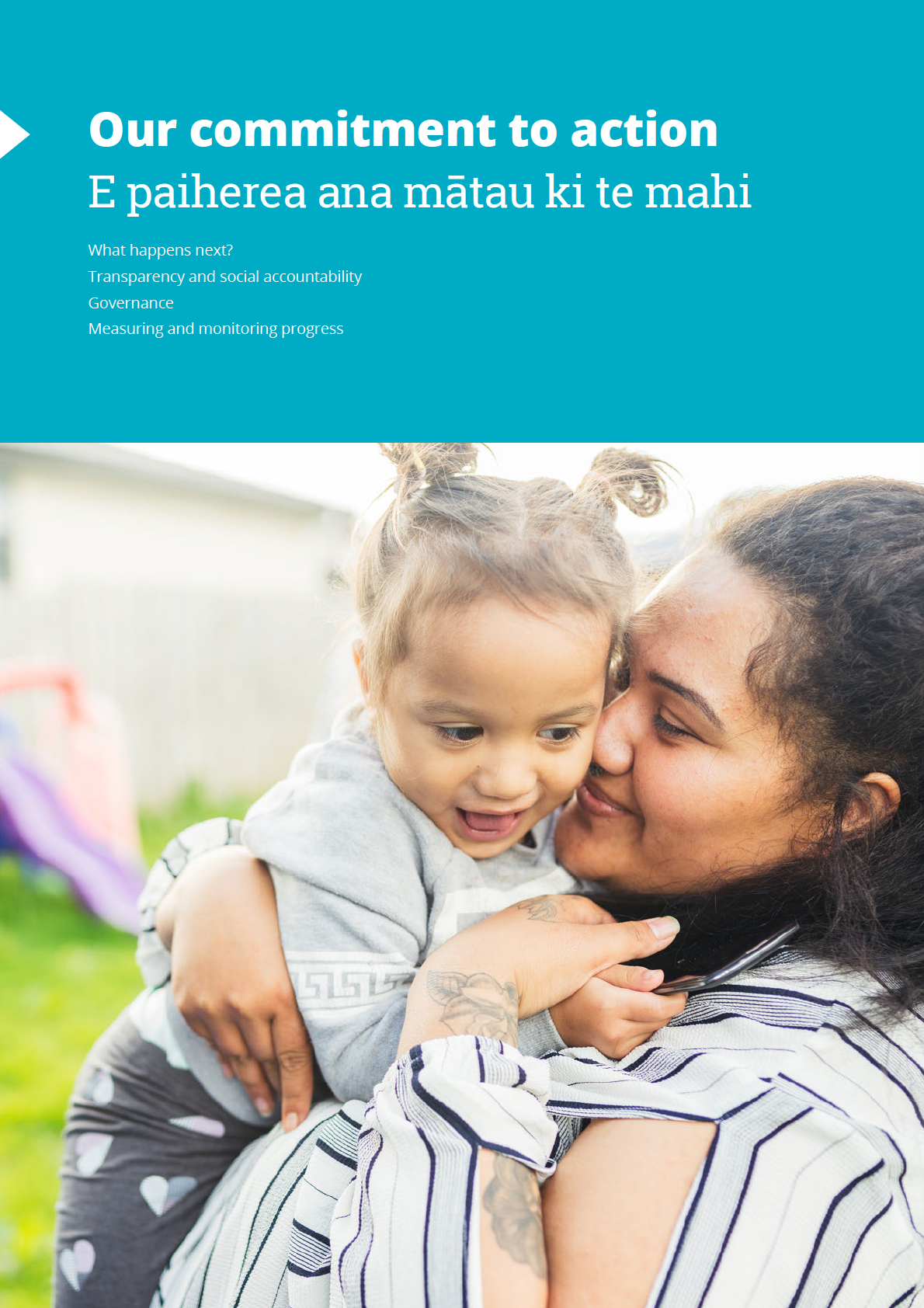
under the Official Information Act 1982
Released
8. Our commitment to action
E paiherea ana mātau ki te mahi
Producing a strategy is not the end of thinking about resilience –
it’s the beginning.
Ehara te whakairo rautaki i te whakamutunga o te whakaaro mō te
manawaroa – he tīmatanga kē.
8.1 What happens next?
Efforts to tackle the challenge of accountability have
The job of the Strategy is to show what we want to achieve
traditionally tended to concentrate on improving the ‘supply
over the next ten years. It’s deliberately high level with
side’ of governance, including methods such as political
objectives broadly described. Specific actions to implement
checks and balances, administrative rules and procedures,
the Strategy are not included - doing so would make it long,
auditing, and formal enforcement processes.
cumbersome and inflexible.
These are still important, and will be built into the process
The Ministry of Civil Defence & Emergency Management
to monitor this Strategy. However, we also want to pay
will, during 2019, coordinate the preparation of a roadmap
attention to the ‘demand side’ of good governance:
of actions setting out how the Strategy objectives will be
strengthening the voice and capacity of all stakeholders
achieved. Its emphasis will be on work to be done over the
(including the public, and any groups disproportionately
next 3-5 years (and be updated overtime).
affected by disasters), to demand greater accountability and
responsiveness from authorities and service providers.
The roadmap will acknowledge the range of initiatives that
contribute to the Strategy’s objectives. Examples of these
Enhancing the ability of the public to engage in policy,
are:
planning, and practice is key.
• The implementation of the Emergency Management
We must find ever-more effective and practical ways to do
System Reforms to improve how New Zealand responds
this. This could include activities such as: representation
to natural disasters and emergencies
on governance or planning groups, deliberate efforts to
• Revised Civil Defence Emergency Management Group
engage different stakeholder groups on specific challenges,
plans and the National Civil Defence Emergency
citizen or civil society-led action, or utilising the whole new
Management Plan (which must be reviewed by
generation of engagement offered by social media.
December 2020)
• Climate change adaptation initiatives
8.3 Governance of this Strategy
The Strategy will be owned and managed by existing
The roadmap will include work about how best to give effect
governance mechanisms, including those through the
under the Official Information Act 1982
to the Strategy’s aim of a whole-of-society, inclusive, and
National Security System, and at a regional level by
collective approach to building resilience.
CDEM Groups.
Holding ourselves to account is paramount.
The process to develop a roadmap of actions will include
It is envisaged that this can be achieved in three main ways:
work to identify practical ways to strengthen the voice and
a principle of transparency and social accountability, formal
capacity of all stakeholders, including the public, and those
governance mechanisms, and measuring and monitoring
disproportionately affected by disasters.
progress.
8.2 Transparency and social accountability
Released
It is critical that we are transparent about both our risks
and our capacity to manage them. It is only by exposing the
issues and having open conversations that we will make
progress on overcoming barriers, and build on strengths
and opportunities.
36 National Disaster Resilience Strategy | Rautaki Manawaroa Aituā ā-Motu | DRAFT FOR CONSULTATION
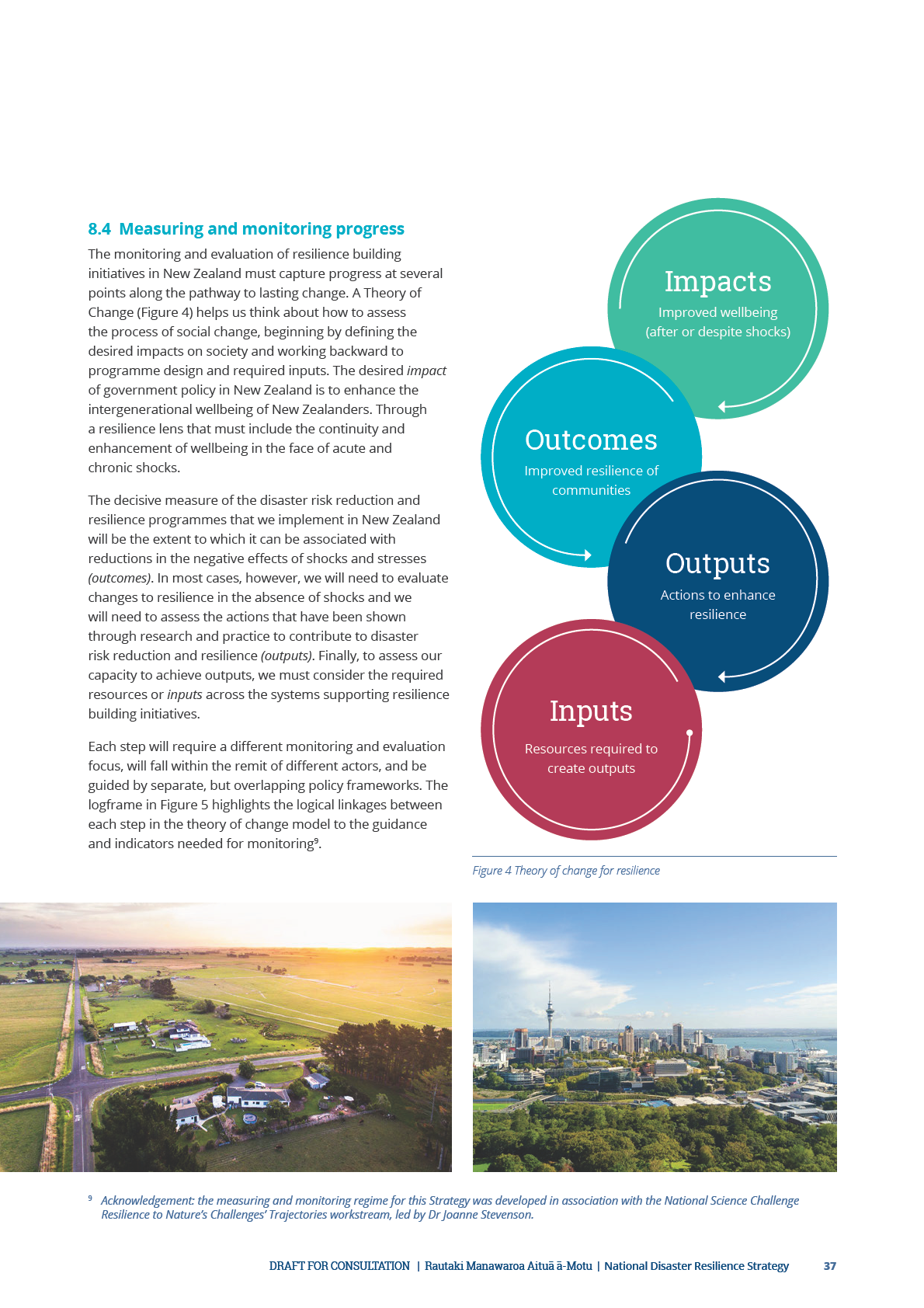
under the Official Information Act 1982
Released
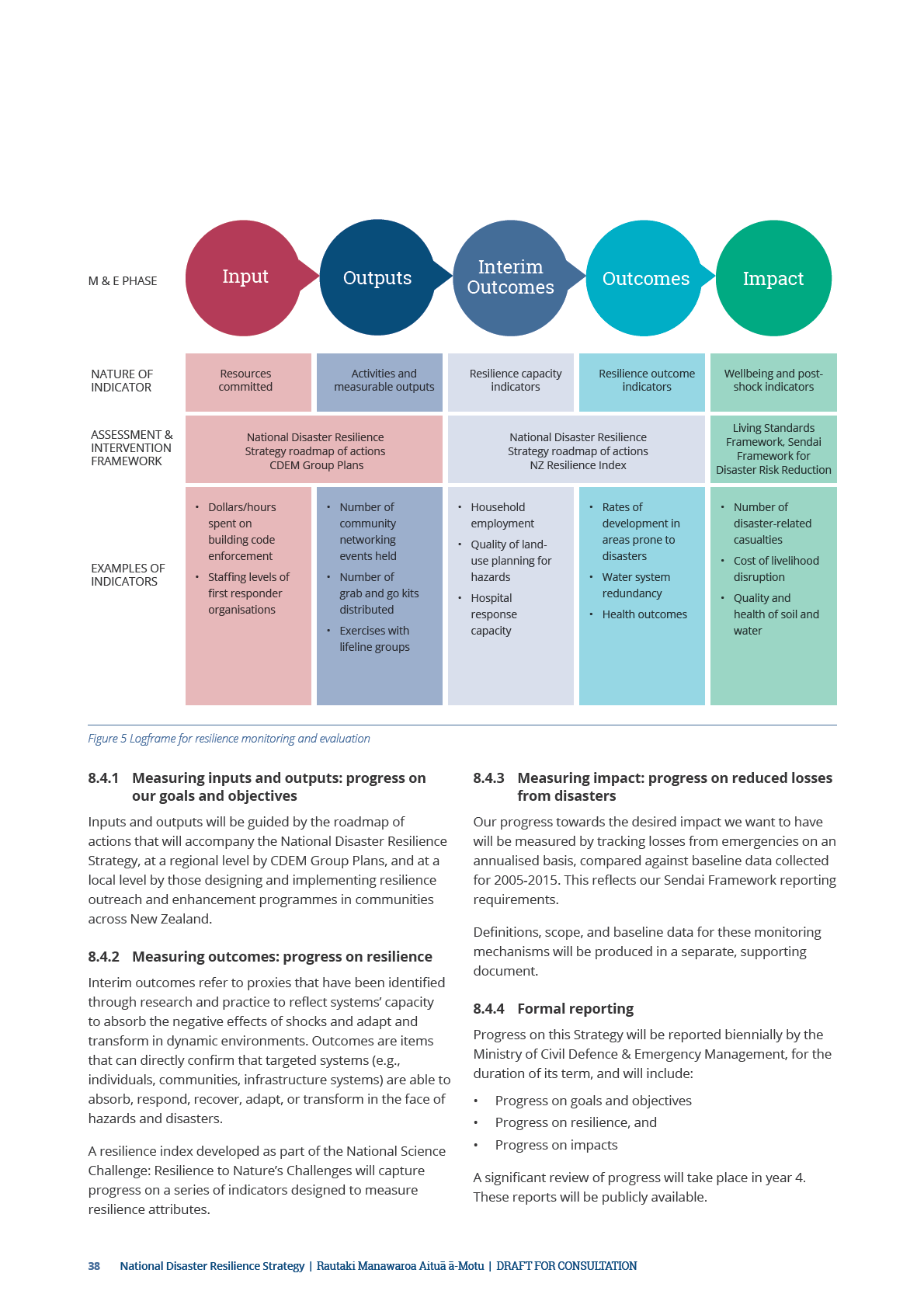
under the Official Information Act 1982
Released

under the Official Information Act 1982
Released
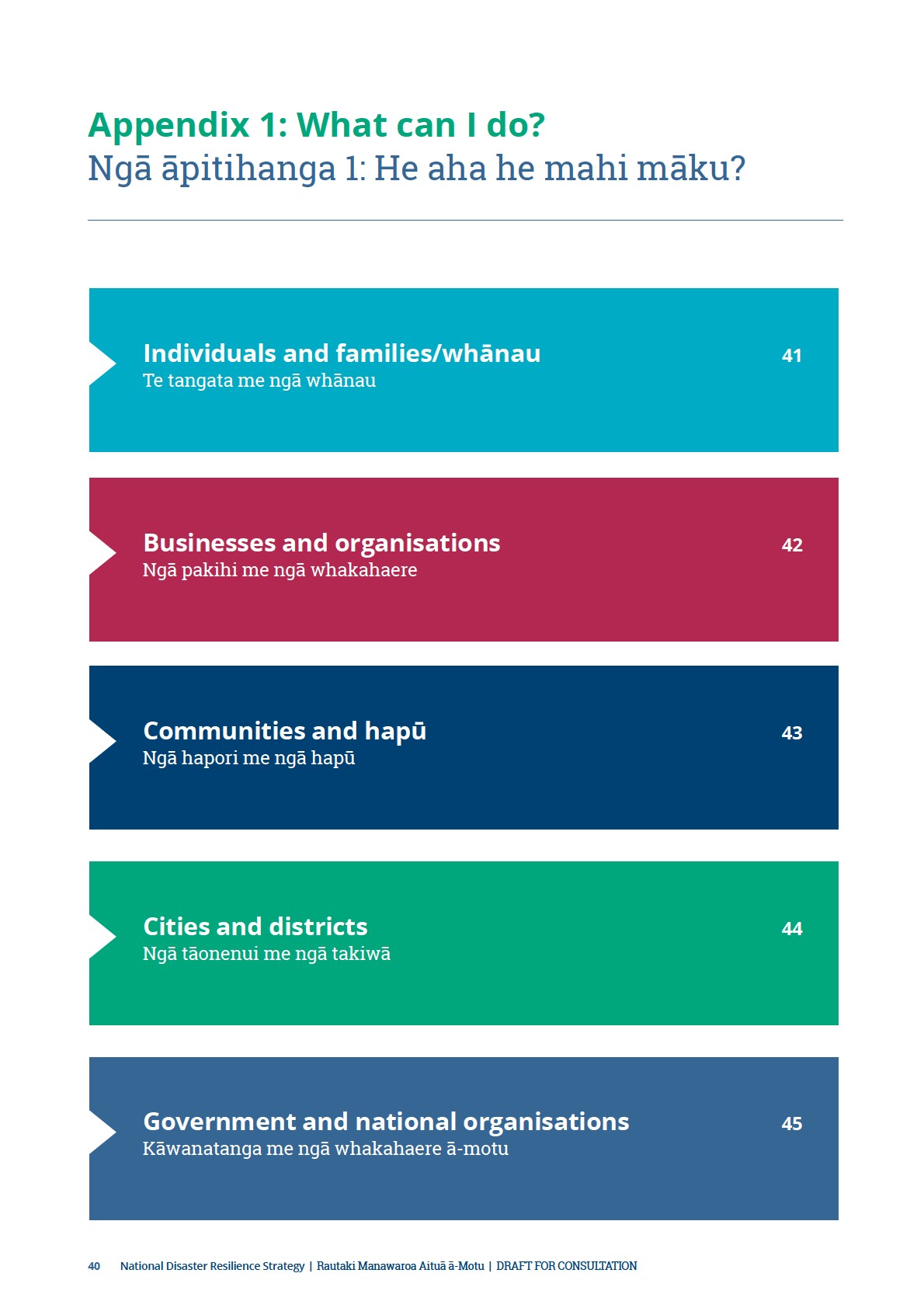
under the Official Information Act 1982
Released
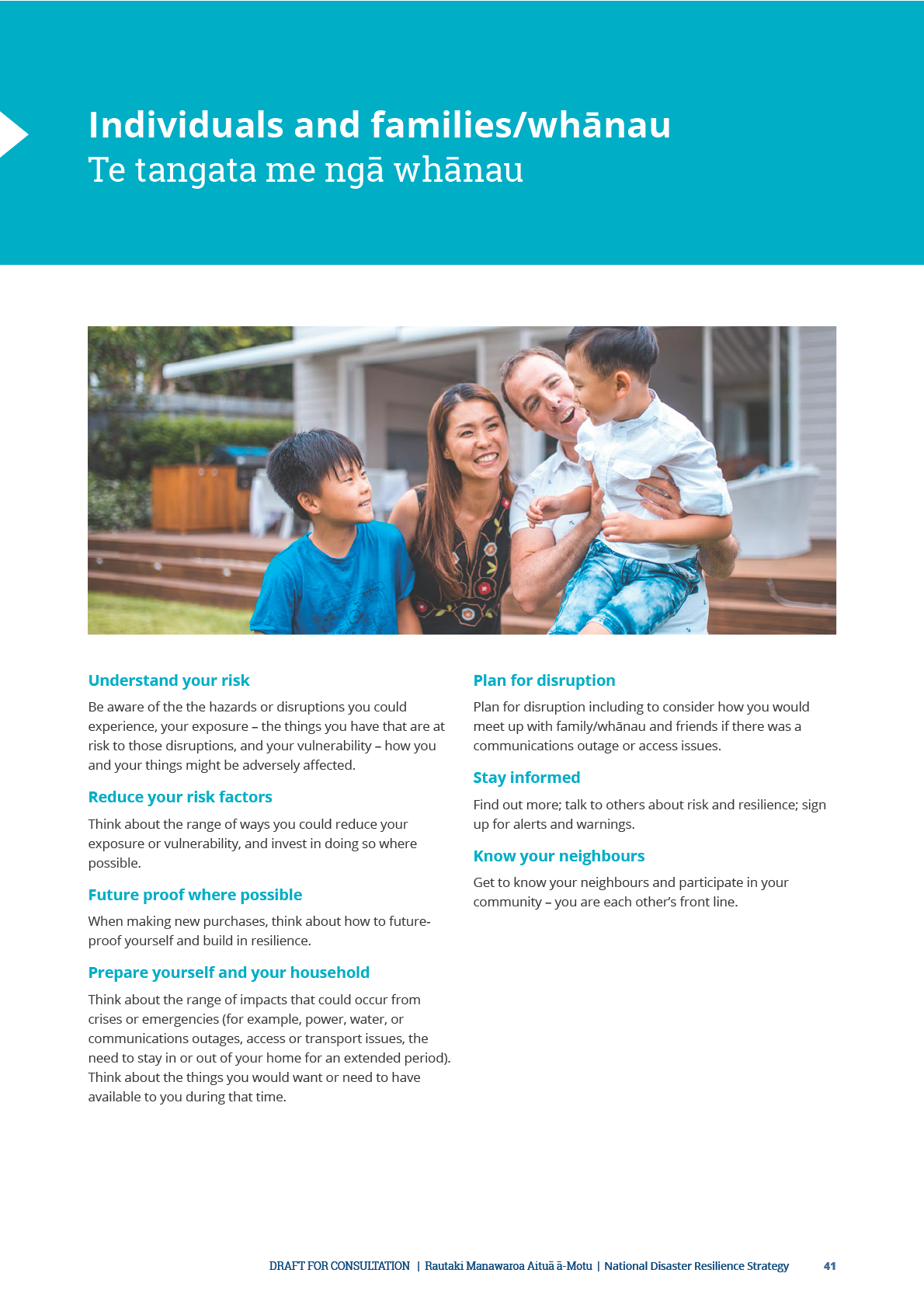
under the Official Information Act 1982
Released
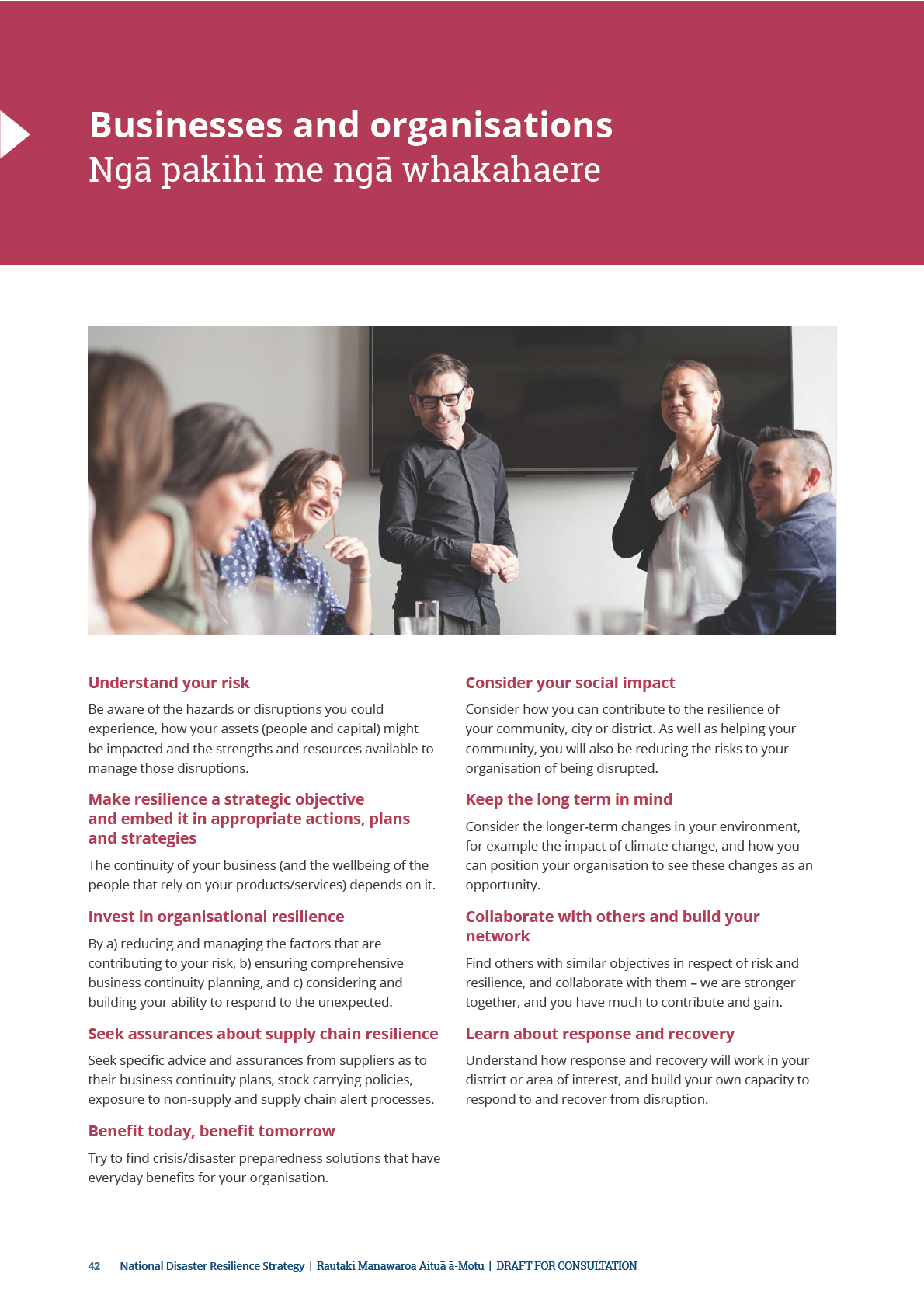
under the Official Information Act 1982
Released

under the Official Information Act 1982
Released
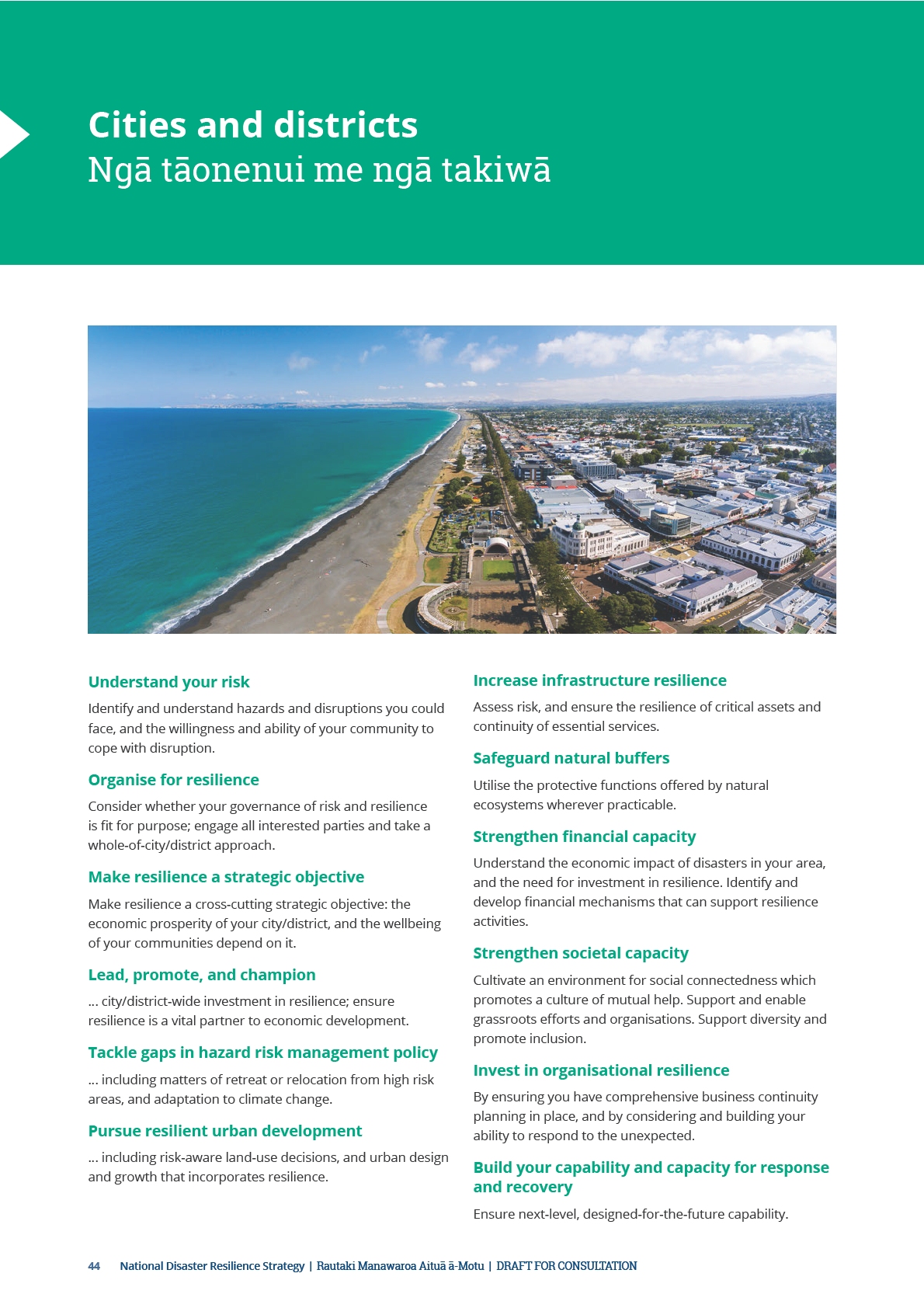
under the Official Information Act 1982
Released
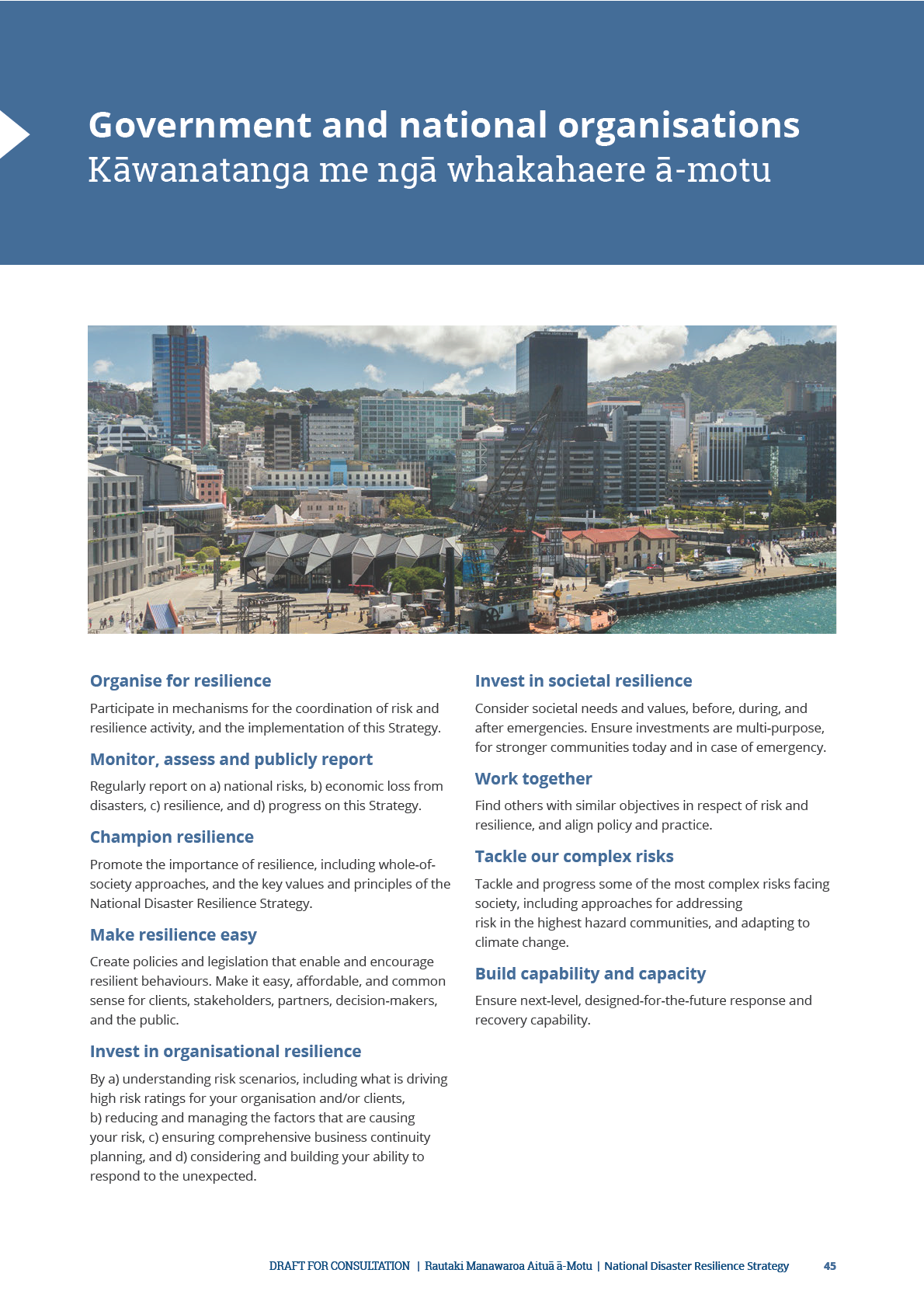
under the Official Information Act 1982
Released
Appendix 2: Analysis of our current state as
a baseline for this Strategy
In order to form an effective strategy for the future and move towards a state of enhanced resilience, it is useful to look at
our current state – our strengths, barriers, and opportunities – and how we capitalise on areas of strength and opportunity,
overcome obstacles to progress, and make the smartest possible choices about actions and investment. Furthermore, in the
quest to be ‘future ready’, it is useful to consider what other environmental and societal trends are occurring around us, even
now, and how we can use them to build our resilience.
Strengths
New Zealand already has a number of strengths in respect
risk management, including the CDEM Act 2002, the
of disaster resilience.
Resource Management Act 1991, the Building Act 2004,
the Local Government Act 2002, and a range of other
1. We have good social capital in our communities. New
legislation and regulatory instruments. This includes
Zealand communities are aware, knowledgeable,
regulation for land-use and building standards – critical
passionate, and well-connected. In general, they have
factors in building more resilient futures.
a strong sense of local identity and belonging to their
8. We have an effective national security coordination
environment, a belief in manaakitanga and concern for
system that takes an all-hazards approach and has
their fellow citizens, and a sense of civic duty.
governance at the political, executive, and operational
2. We are a developed country that has comprehensive
levels.
education, health, and social welfare systems, which
9. At the regional level consortia of local authorities,
build our people and look after the most vulnerable
emergency services, lifeline utilities, and social welfare
in society.
agencies (government and non-government) form CDEM
3. We have a strong cultural identity, including the special
Groups that coordinate across agencies and steward
relationship between Māori and the Crown provided
emergency management in their regions.
through the Treaty of Waitangi. New Zealand is also
10. We have an engaged and well connected science
one of a handful of culturally and linguistically ‘super-
community, including a number of platforms specifically
diverse’ countries, which brings a number of economic
targeting the advancement of knowledge and
and social benefits, and expanded knowledge and
understanding about natural hazards and resilience.
experience (the ‘diversity dividend’). We value our
In general, there are good links between scientists,
culture, our kaupapa and tikanga. We celebrate and
policy makers and practitioners. Scientists practice an
foster a rich and diverse cultural life.
increasing level of community outreach, engage in a
4. We have a high-performing and relatively stable
co-creation approach, and are focussed on outcomes.
economy. The New Zealand economy made a solid
11. Organisations and agencies work well together. While
recovery after the 2008-09 recession, which was shallow
there’s always room for improvement, a multi-agency
under the Official Information Act 1982
compared to other advanced economies. Annual growth
approach is the ‘norm’, which means better coordination
has averaged 2.1% since March 2010, emphasising the
of activities, more efficient use of resources, and better
economy’s resilience.
outcomes.
5. We have very high insurance penetration across
12. We are a small country, which makes us well-connected,
residential property. Most countries struggle to get their
uncomplicated, and agile. We can ‘get things done’ in
ratio of insured to non-insured up to an acceptable level.
relatively short order.
Because of the Earthquake Commission, New Zealand’s
13. We are experienced. We have seemingly had more than
residential insurance penetration is 98%. This means
our fair share of crises, emergencies, and disasters over
that a good proportion of the economic costs of most
Released
the last ten years. This has brought some bad times,
natural hazard events are covered by re-insurance.
but the silver lining is the awareness that it has built in
6. We have a stable political system, low levels of
everyone, the knowledge about ‘what works’ and what is
corruption, and freedom of speech.
needed, and the willingness to act.
7. We have a good range of policy in place for disaster
46 National Disaster Resilience Strategy | Rautaki Manawaroa Aituā ā-Motu | DRAFT FOR CONSULTATION
Barriers to resilience
While we have a lot going for us, we also have some things that limit our resilience. The process to develop this Strategy
identified a number of barriers to resilience, and barriers to our pursuit of resilience.
What is limiting our resilience?
What is limiting our pursuit of resilience?
1. Some of our people still suffer considerable poverty,
1. Not enough people and organisations are taking action
social deprivation, and/or health issues that limit
to prepare or build their resilience for disasters. This is
wellbeing, quality of life, and resilience.
generally either because it is seen as too expensive or
2. Our level of individual and household preparedness for
difficult, because of other priorities, because it ‘might
emergencies (including preparedness for our animals) is
never happen’, or because of an expectation of a rapid
not as high as it should be, given our risks.
and comprehensive institutional response.
3. Our businesses and organisations (including those
2. Building community resilience – even where playing a
involving animals) are not as prepared as they could
facilitative role – is resource intensive. It also requires a
be, leading to loss of service and losses in the economy
high level of skill and understanding to navigate diverse
when severe disruption strikes.
communities and complex issues.
4. Some of our critical assets and services are ageing and
3. Emergency management issues tend to be ‘headline’
vulnerable. These are in most places being addressed
issues that require immediate corrective action. This is
by asset management plans and asset renewal
understandable, and needed, but means we often focus
programmes, (including strengthening, conservation
more on fixing the problems of the day, and addressing
and restoration), but these will take time (and resources)
issues from the last event, than forecasting the future
to implement.
and taking action for the long-term.
5. We live in some high-risk areas, and are continuing to
4. Risk reduction and resilience are often perceived as
build in high-risk areas – particularly around the coast,
‘expensive’, and limiting of economic development and
on steep slopes, fault lines, reclaimed land, and flood
business growth.
plains. We live and build there because they are nice
5. At the same time, the full cost of disasters often isn’t
places to live, and because sometimes there is no other
visible (particularly the cost of indirect and intangible
choice. However, insurance in these areas may some
impacts, including social and cultural impacts), meaning
day become unaffordable. At some point we need to
it isn’t factored into investment decision-making.
consider – for ourselves, our communities, and for
6. Perverse incentives don’t encourage resilience – too
future generations – how much risk is too much?
often, as a society, we are aiming for the ‘minimum’
6. We are only just starting to tackle some of the ‘truly
standard or ‘lowest cost’. This can deter people from
hard’ issues around existing levels of risk, such as how to
aiming higher or for the ‘most resilient’ solution.
adapt to or retreat from the highest risk areas, including
under the Official Information Act 1982
7. Recovery is often underestimated. The Christchurch
to adapt to the impacts of climate change. There is likely
earthquake recovery and many other smaller events
high cost around many of these options.
have shown us just how complex, multi-faceted, difficult,
7. We have gaps in our response capability and capacity,
expensive, and long-term recovery is. Other parts of
as outlined in a recent Ministerial Review into better
the country need to consider how they would manage
responses to emergencies in New Zealand (Technical
recovery in their city or district, and give priority to
Advisory Group report, 2017). These are predominantly
resourcing capability and capacity improvements.
around capability of individuals, capacity of response
8. We have had difficulty translating resilience theory into
organisations, and powers and authorities of those
action. There is an abundance of academic theory on
individuals and organisations to act. The review also
Released
resilience, but turning that theory into practical action
identified issues with communication and technology, in
has, until recently anyway, been difficult to come by.
particular, the challenges of response intelligence and
communications staying apace with social media.
DRAFT FOR CONSULTATION | Rautaki Manawaroa Aituā ā-Motu |
National Disaster Resilience Strategy 47
Opportunities
As well as strengths and barriers, it is important to consider what opportunities we have or may have on the horizon. The
opportunities the strategy development process has identified are:
1. Awareness and understanding of disasters, disaster
7. The Government has a strong focus on wellbeing,
impacts and disaster risk, is at an all-time high following
particularly intergenerational wellbeing, and
a series of domestic events over the last 5-10 years,
improved living standards for all. Simultaneously,
including the Canterbury and Kaikōura earthquakes.
local government has a renewed interest in the ‘four
This includes a willingness to act on lessons and to do so
wellbeings’ with those concepts being re-introduced
in a smart, coordinated, and collaborative way.
to the Local Government Act as a key role of local
2. Our hazards are obvious and manifest. This is both a
government. These priorities are entirely harmonious,
curse and an opportunity: we have high risk, but we also
and lead swiftly into a conversation with both levels
have an awareness, understanding, and willingness to
of government on how to protect and enhance living
do something about them, in a way that countries with
standards through a risk management and resilience
less tangible risks might not. If we address risk and build
approach.
resilience to our ‘expected’ hazards, we will hopefully
8. We have only just begun to scratch the surface of best
be better prepared for when the ‘less expected’
resilience practice, including how to make the most of
hazards occur.
investment in resilience. There is much to learn from the
3. We have an incredible wealth of resilience-related
Triple Dividend of Resilience [see page 51] – ensuring
research currently underway, including several multi-
our investments provide multiple benefits or meet
sectoral research platforms that aim to bring increased
multiple needs, and are the smartest possible use of
knowledge to and improved resilience outcomes for
limited resources. The Triple Dividend also supports
New Zealanders. Over the next few years there will be
better business cases, allowing us to better position our
a steady stream of information about ‘what works’, and
case for resilience and convince decision-makers of the
tried and tested methodologies we can employ in all
benefits of investment.
parts of society.
9. We are a small agile nation. We are ambitious,
4. We also have a lot of other work – in terms of resilience-
innovative, motivated, and informed: we can lead the
related policy and practice – underway in organisations
world in our approach to resilience.
at all levels and across the country. Connecting the
pieces of the jigsaw, sharing knowledge, and working
together should enable even more improved outcomes.
5. There is a particular opportunity for building processes
that support collective impact. Collective Impact is a
under the Official Information Act 1982
way of organising a range of stakeholders around a
common agenda, goals, measurement, activity, and
communications to make progress on complex societal
challenges. [see page 50]
6. The introduction of the three post-2015 development
agendas (Sendai Framework, Sustainable Development
Goals, and Paris Agreement for Climate Change) brings
an additional impetus and drive for action, as well as
practical recommendations that we can implement.
Released
They also bring a strong message about integration,
collaboration, and a whole-of-society approach.
48 National Disaster Resilience Strategy | Rautaki Manawaroa Aituā ā-Motu | DRAFT FOR CONSULTATION
‘Wild cards’
The world is changing at an unprecedented rate driven by technical innovation and new ways of thinking that will
fundamentally transform the way we live. As we move away from the old structures and processes that shaped our past,
a new world of challenges and opportunities awaits us. While there might be uncertainty about how some of these factors
might shape our risk and our capacity to manage that risk, there are some common implications that are critical to take
account of as we work to build resilience.
1. The revolution in technology and communication is a
5. High levels of trust across organisations, sectors and
key feature of today’s world. Regardless of the issue,
generations will become increasingly important as a
technology is reshaping how individuals relate to one
precondition for influence and engagement. This trust
another. It shifts power to individuals and common
will need to be based on more than just the existence of
interest groups, and enables new roles to be played
regulations and incentives that encourage compliance.
with greater impact. Organisations and groups that
Organisations can build trust among stakeholders
can anticipate and harness changing social uses of
via a combination of “radical transparency” and by
technology for meaningful engagement with societal
demonstrating a set of social values that drive behaviour
challenges will be more resilient in the future.
that demonstrates an acknowledgement of the
common good.
2. Local organisations and grassroots engagement is an
important component. This is driven in part by the
6. The possibility of new and innovative partnerships
aforementioned technology and communication shifts
between government, the private and not-for-profit
that give local groups more influence and lower their
sectors, may provide new platforms for positive change.
costs for organising and accessing funding, but also
The challenge of disaster risk can no longer be the
the rising power of populations in driving actions and
domain of government alone. A collective approach is
outcomes.
needed, including to utilise all resources, public and
private, available to us, and to consider innovative
3. Following on from these, populations currently under
approaches to managing and reducing risk. This
the age of 30 will be a dominant force in the coming two
requires active participation on the part of the private
decades – both virtually, in terms of their levels of online
sector, and transparency, openness, and responsiveness
engagement, and physically, by being a critical source of
on the part of politicians and public officials.
activity. Younger generations possess significant energy
and global perspectives that need to be harnessed for
7. The need for higher levels of accountability,
positive change.
transparency, and measurement. More work is required
to ensure that those tackling societal challenges have
4. The role of culture as a major driver in society, and
the appropriate means of measuring impact. These
one that desperately needs to be better understood
mechanisms will need to be technology-enabled,
by leaders across governments, the private sector, and
under the Official Information Act 1982
customised to the challenge at hand, and transparent.
civil society. Culture is a powerful force that can play a
significant role (both positive and negative, if it is not
handled sensitively), and is therefore a force with which
stakeholders should prepare to constructively engage.
Released
DRAFT FOR CONSULTATION | Rautaki Manawaroa Aituā ā-Motu |
National Disaster Resilience Strategy 49
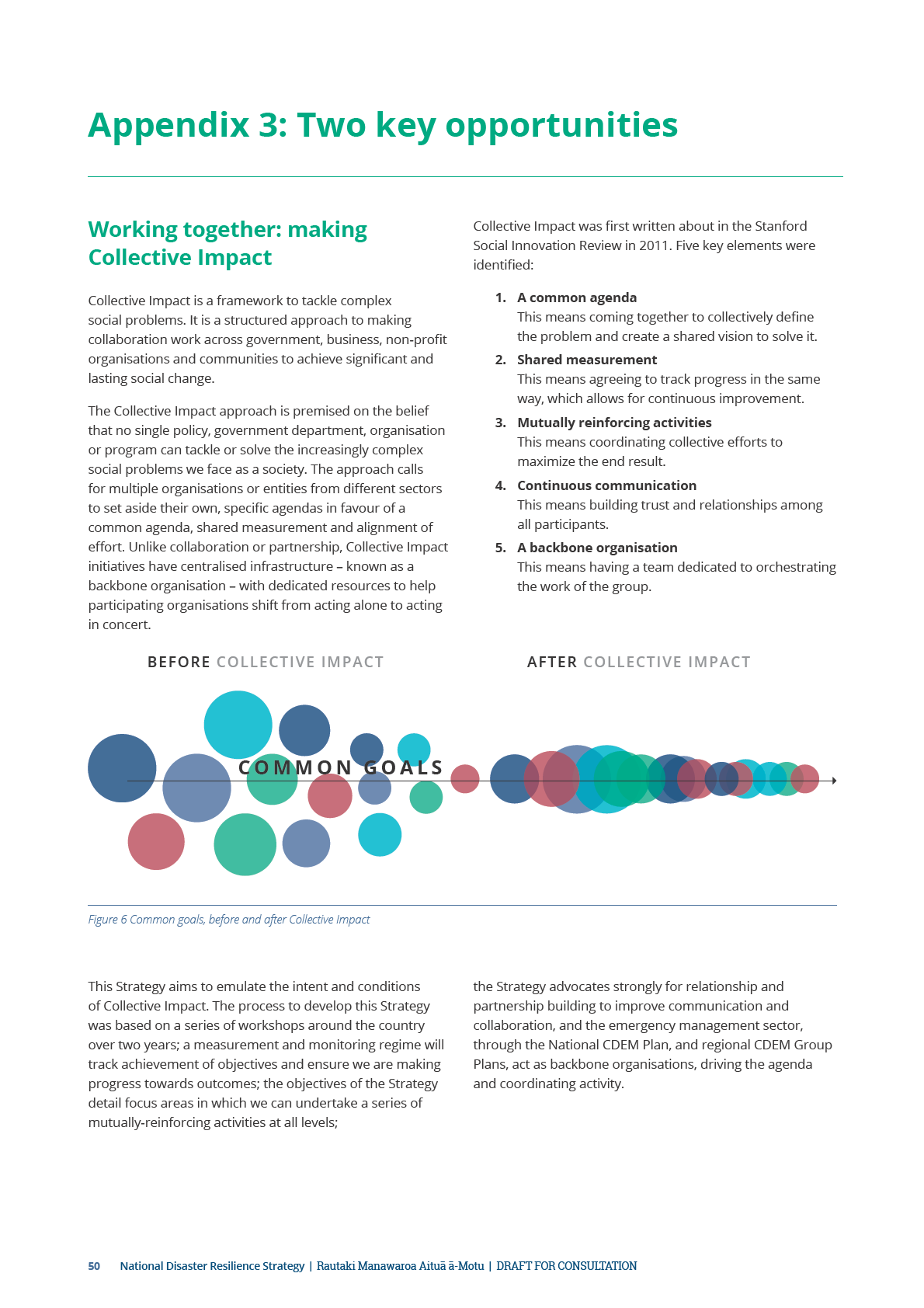
under the Official Information Act 1982
Released
Changing the narrative:
However, there is increasing evidence that building
the Triple Dividend of Resilience
resilience yields significant and tangible benefits, even if a
disaster does not happen for many years – or ever.
In New Zealand we have first-hand, recent examples of
A 2015 report outlines the ‘Triple Dividend of Resilience’, or
how much disasters can cost. The direct costs alone can
the three types of benefits that investments in disaster risk
be significant; as we start to consider methodologies for
management can yield. They are:
counting the economic cost of social impact, the total cost of
1. Avoiding losses when disasters strike
disasters and disruptive events will be significantly more –
maybe even double the reported ‘direct’ costs.
2. Stimulating economic activity thanks to reduced
disaster risk, and
Even so, it is often difficult to make a case for investment
3. Generating societal co-benefits.
in disaster risk management and resilience, even as we cite
research on benefit-cost ratios – how upfront investment in
While the first dividend is the most common motivation
risk management can save millions in future costs. We know
for investing in resilience, the second and third dividends
these ratios to be true, we have seen examples of it, even
are typically overlooked. The report presents evidence that
here in New Zealand, so why is it such a hard case to make?
by actively addressing risk, there can be immediate and
significant economic benefits to households, the private
Other than short-term political and management cycles,
sector, and, more broadly, at the macro-economic level.
it is generally due to how we calculate ‘value’. Traditional
Moreover, integrating multi-purpose designs into resilience
methods of appraising investments in disaster risk
investments can both save costs, and provide community
management undervalue the benefits associated with
and other social benefits (for example, strengthened flood
resilience. This is linked to the perception that investing
protections works that act as pedestrian walkways, parks
in disaster resilience will only yield benefits once disaster
or roads).
strikes, leading decision-makers to view disaster risk
management investments as a gamble that only pays off
New Zealand needs to learn from this concept and ensure that
in the event of a disaster – a ‘sunk’ cost, that gives them no
our investments in resilience are providing multiple benefits to
short-term benefit.
both make smart use of our limited resources, and to assure
decision-makers that their investment is worthwhile, and will
pay dividends – in the short and long term.
1st Dividend of Resilience: Avoided Losses
Increased resilience reduces disaster losses by:
Benefits
1ST OBJECTIVE
1. Saving lives
when
2. Reducing infrastructure damage
diasters
3. Reducing economic losses
strikes
under the Official Information Act 1982
INVESTMENTS IN
2nd Dividend of Resilience: Economic Development
DISASTER RISK
Increased resilience unlocks suppressed economic
MANAGEMENT
2ND OBJECTIVE
potential and stimulates economic activity by:
AND RESILIENCE
1. Encouraging households to save and build assets
2. Promoting entrepeneurship
Benefits
3. Stimulating businesses to invest and innovate
regardless
of disaster
Released
3rd Dividend of Resilience: Co-benefits
3RD OBJECTIVE
Beyond increasing resilience, disaster risk management
investment also yields positive social, cultural, and
environmental side-benefits (‘co-benefits’)
Figure 7 The Triple Dividend of Resilience Investment – Adapted from: The Triple Dividend of Resilience – Realising development goals through the multiple
benefits of disaster risk management (Global Facility for Disaster Reduction and Recovery, the World Bank, Overseas Development Institute, 2015).
DRAFT FOR CONSULTATION | Rautaki Manawaroa Aituā ā-Motu |
National Disaster Resilience Strategy
51
under the Official Information Act 1982
Released
Item 5: Draft Cabinet Paper National Disaster Resilience Strategy: Approval and Presentation to the House
under the Official Information Act 1982
Released
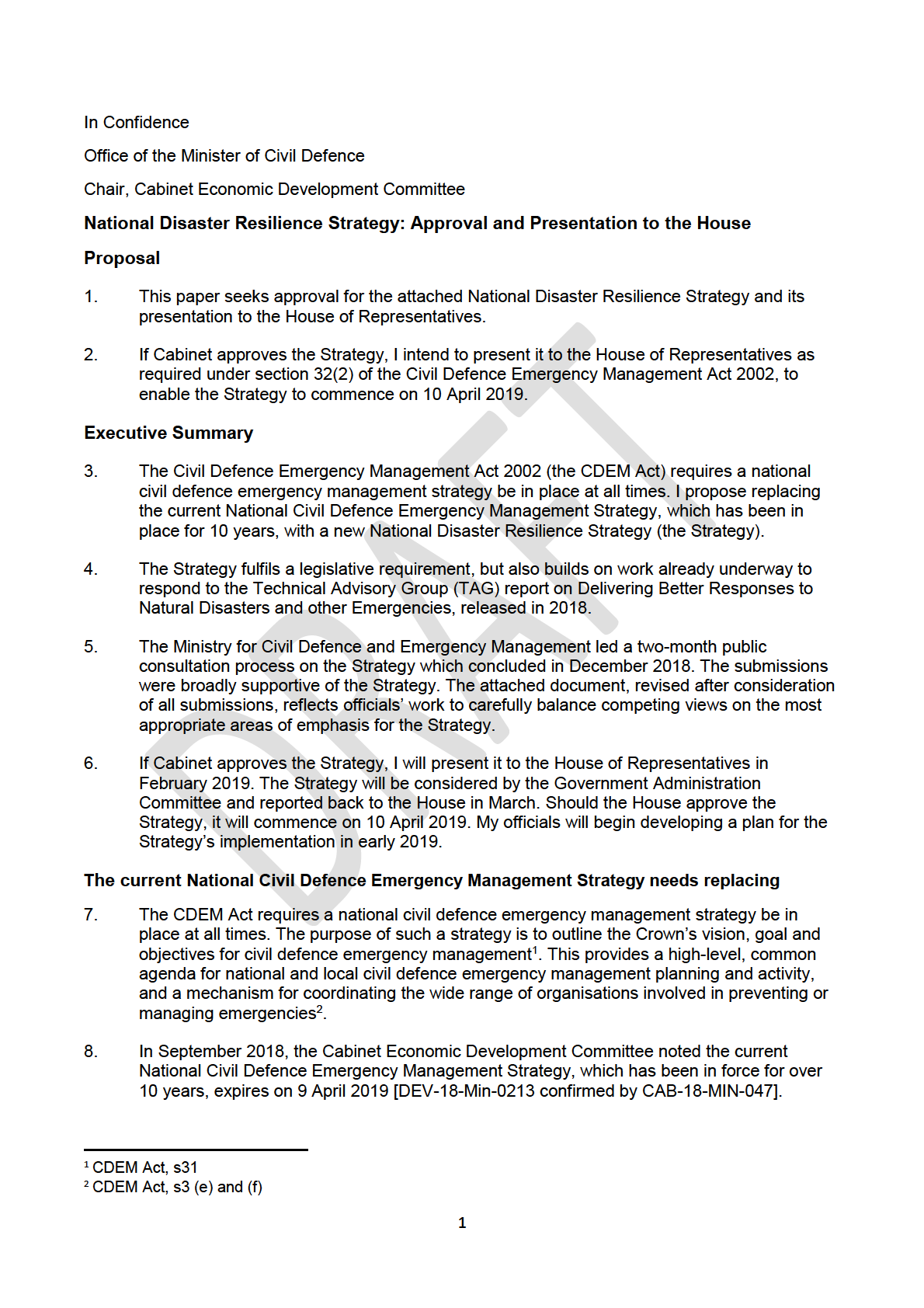
under the Official Information Act 1982
Released
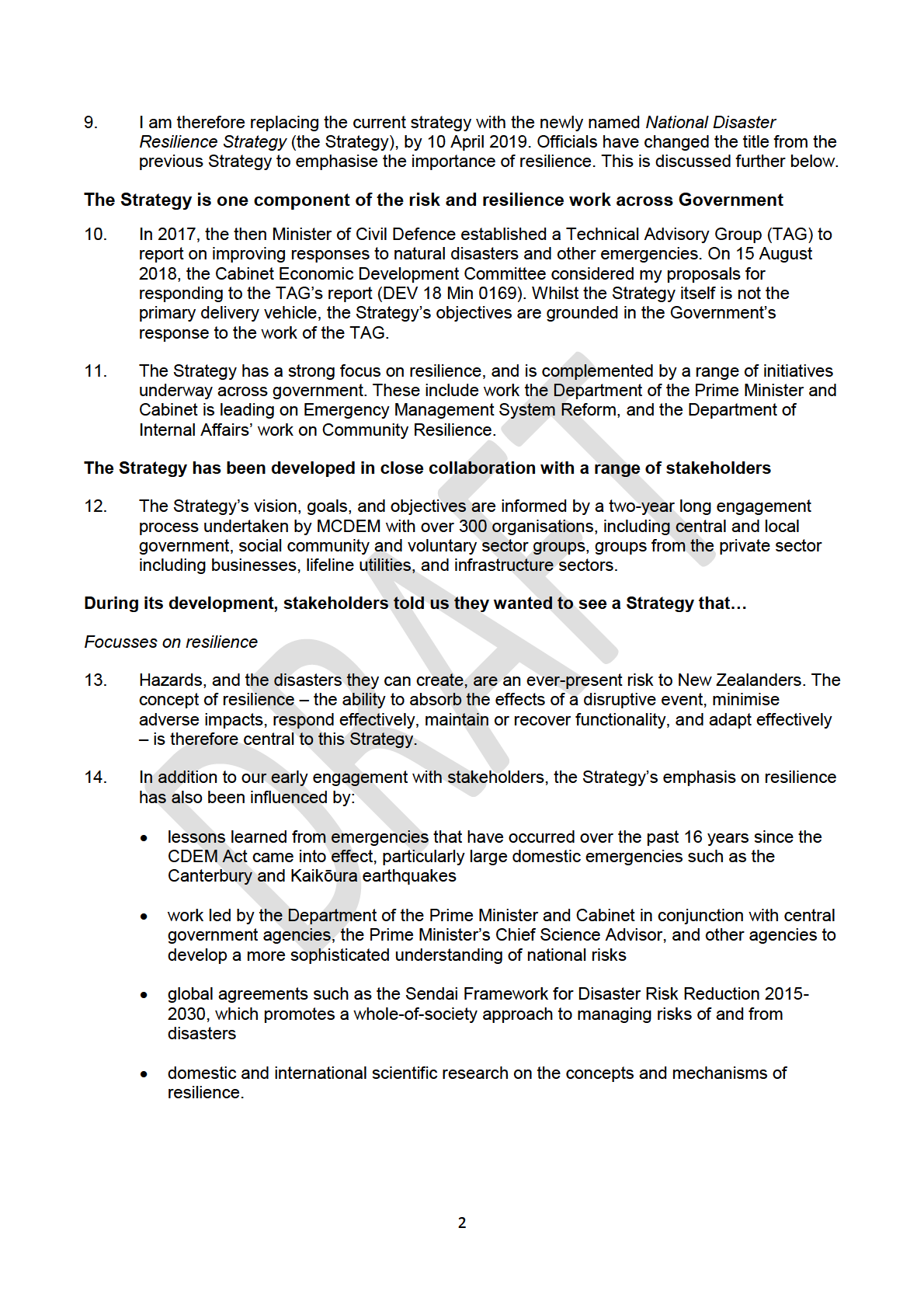
under the Official Information Act 1982
Released
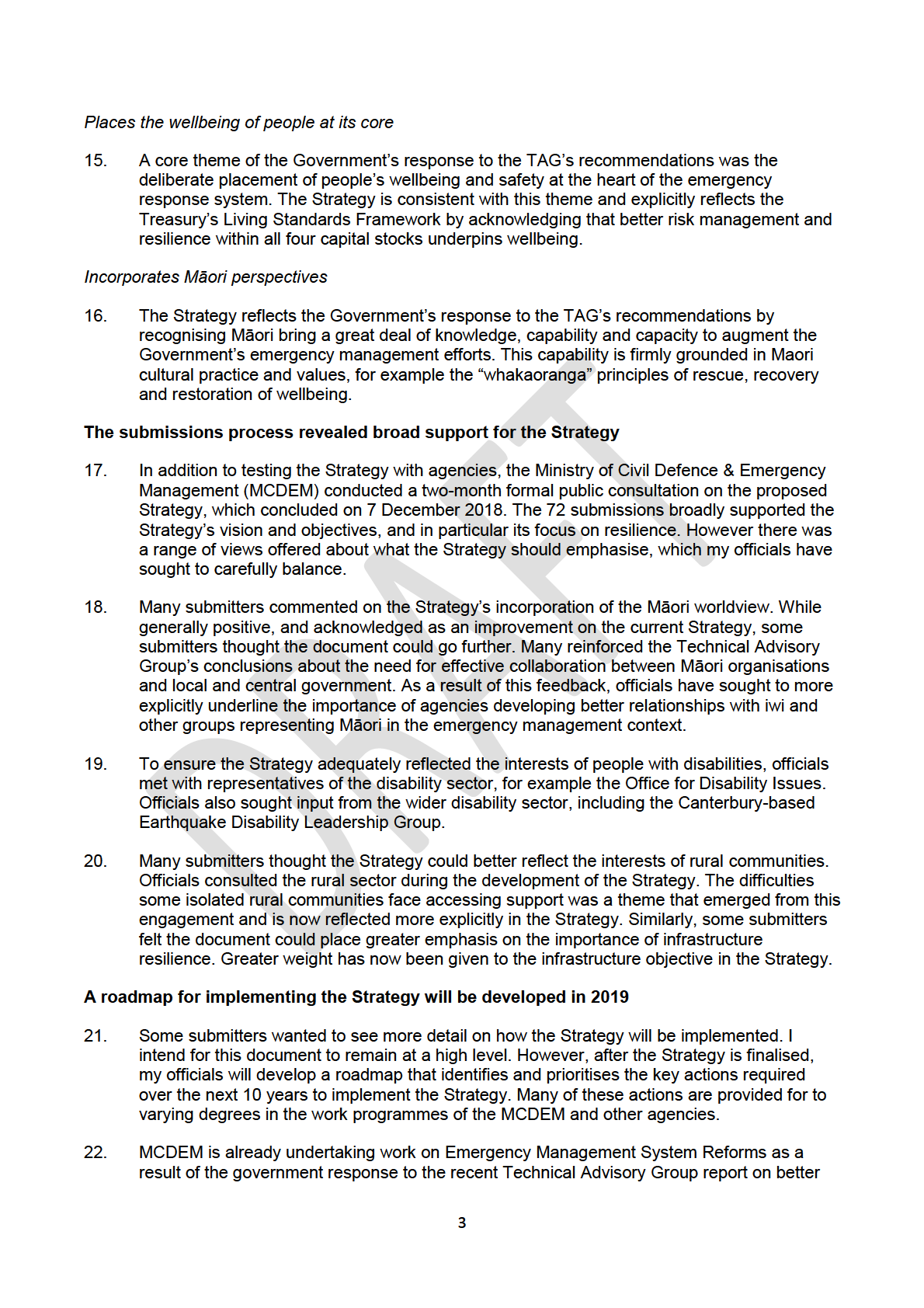
under the Official Information Act 1982
Released
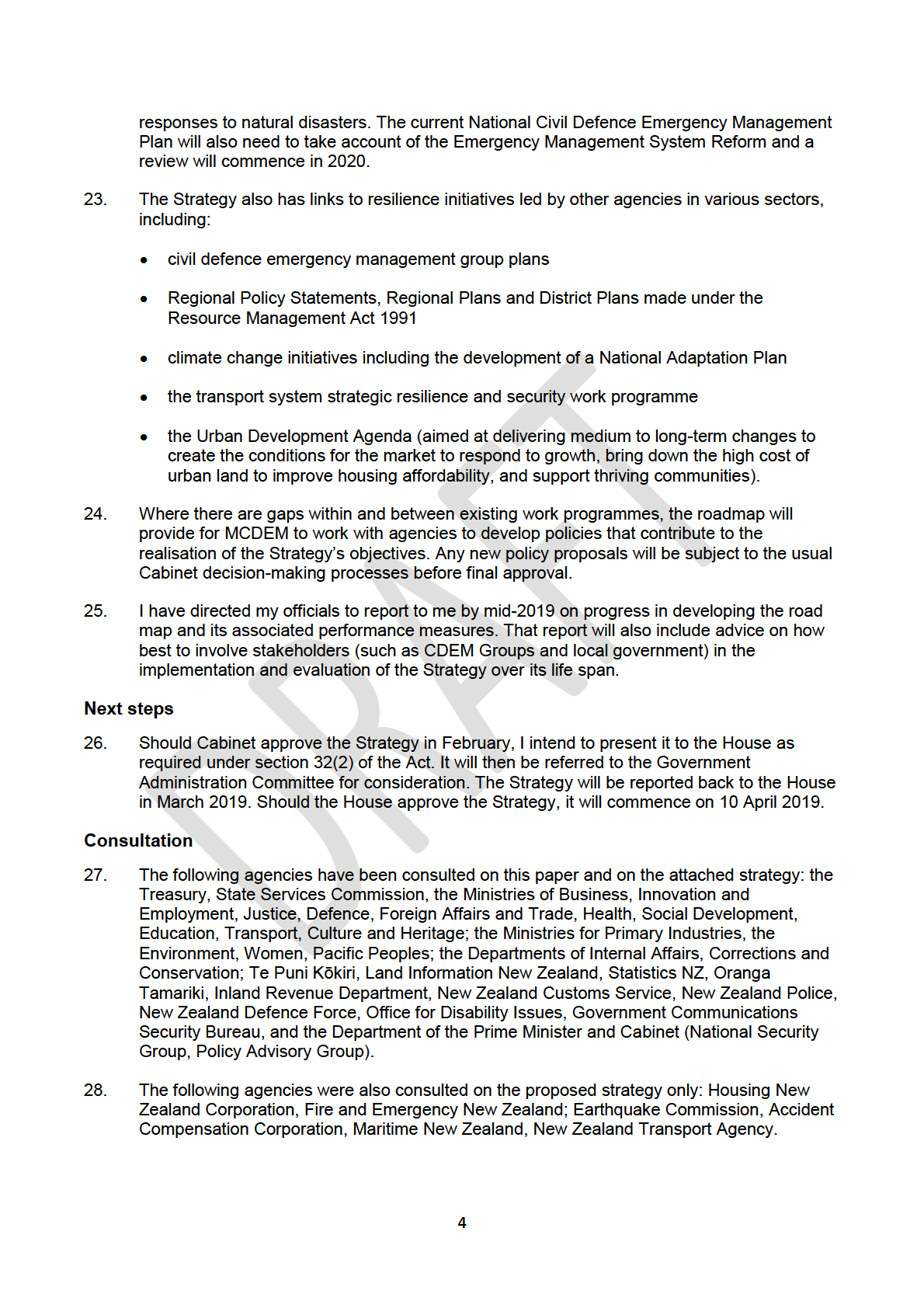
under the Official Information Act 1982
Released
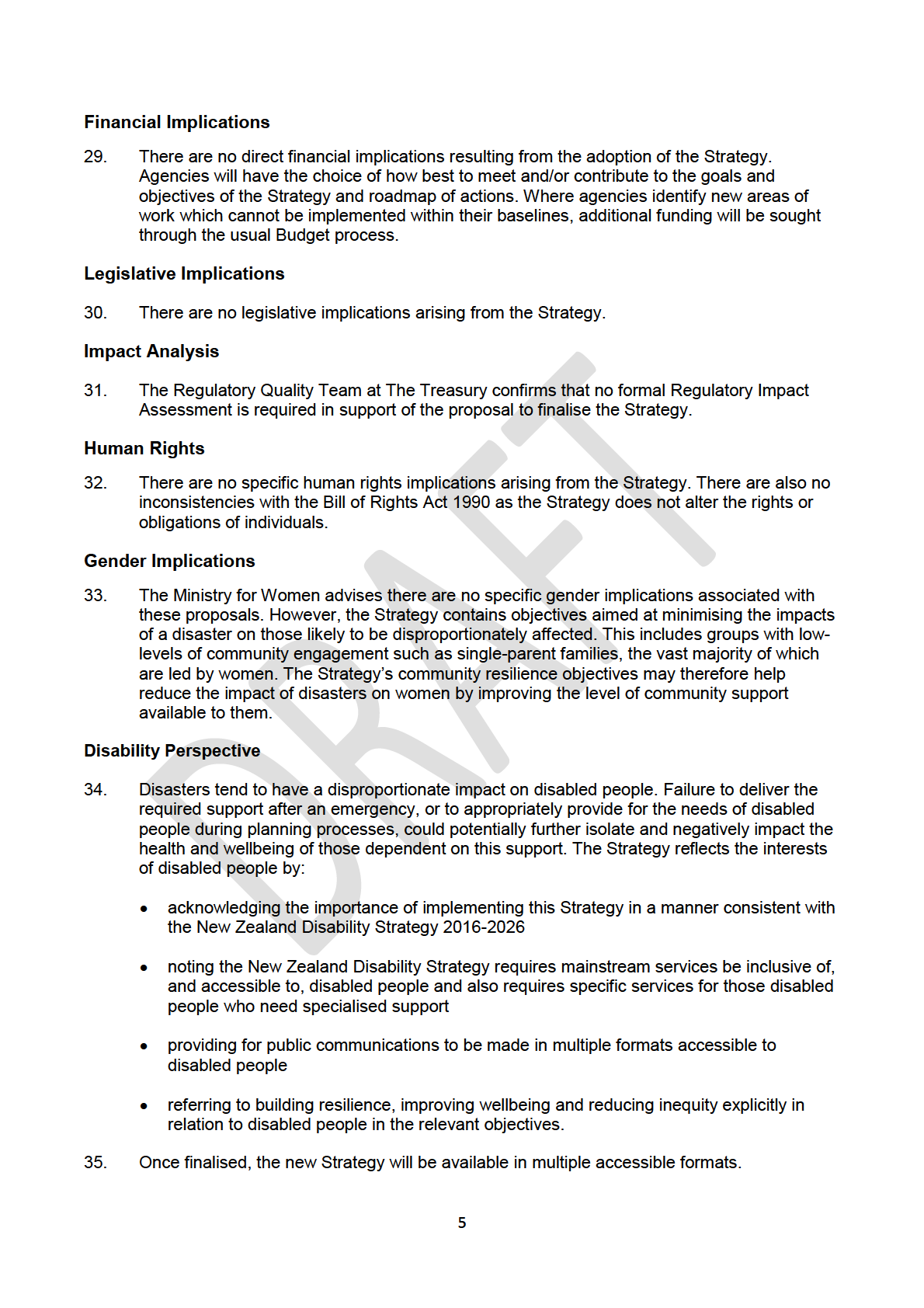
under the Official Information Act 1982
Released
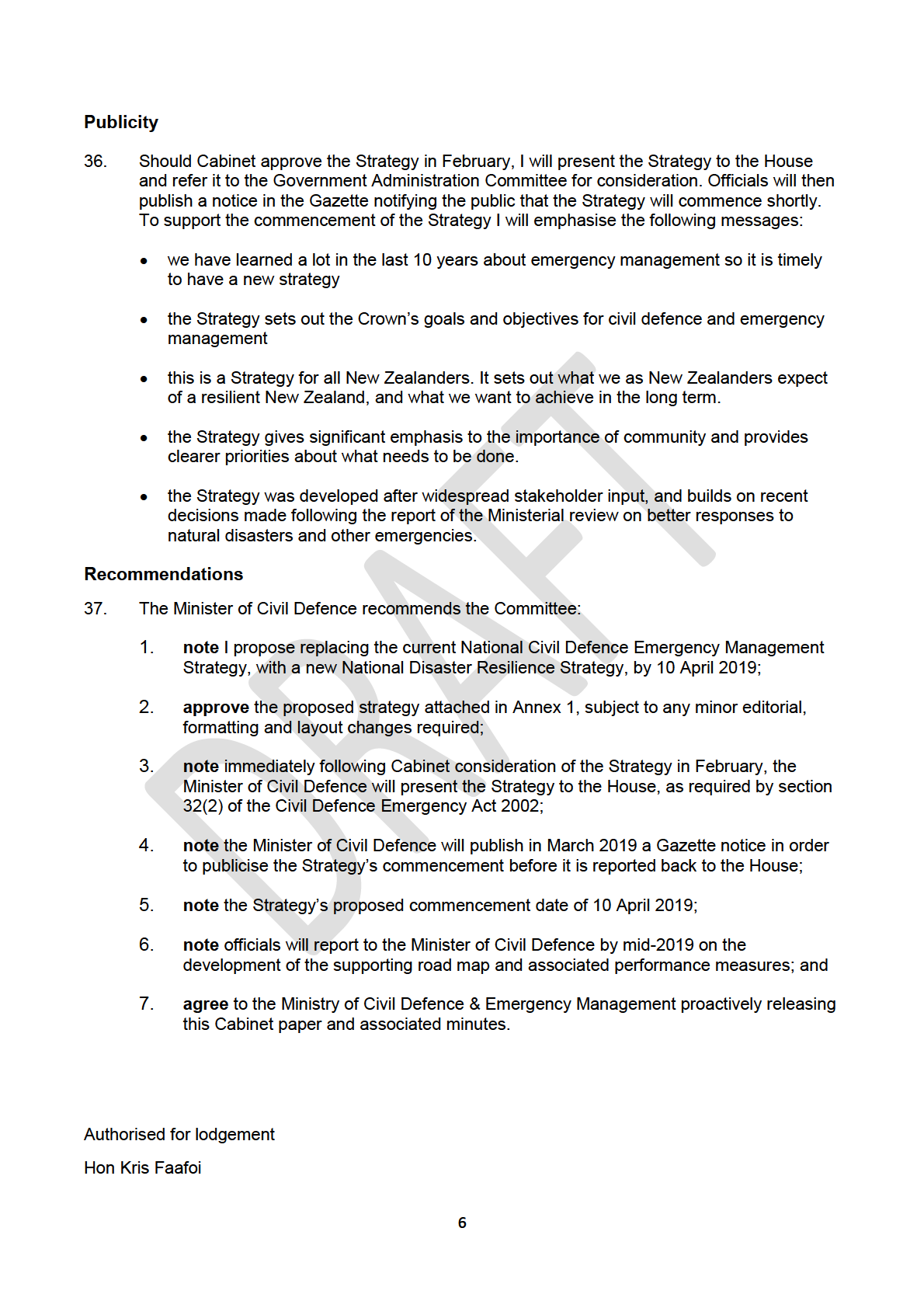
under the Official Information Act 1982
Released
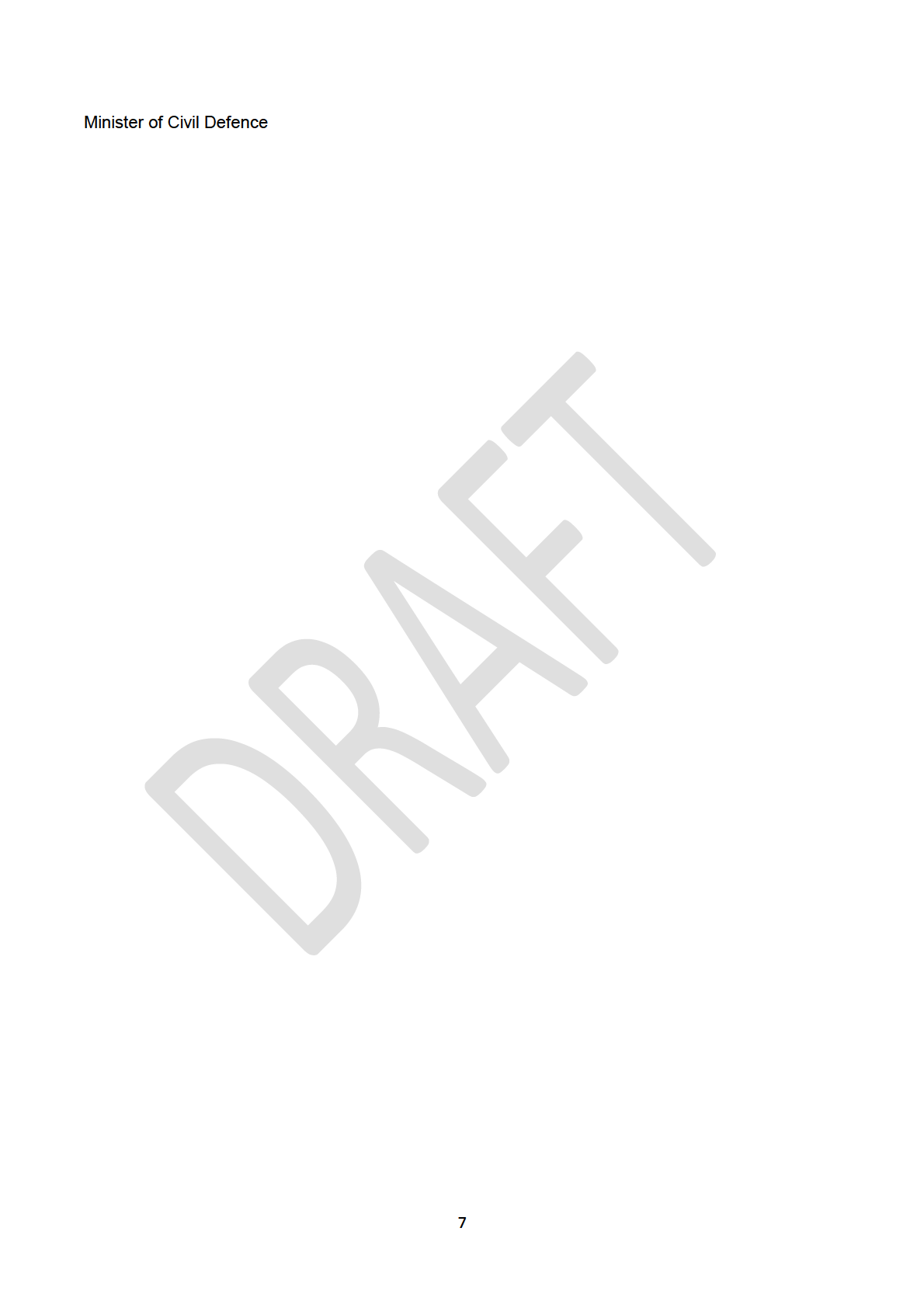
under the Official Information Act 1982
Released
Item 6: Briefing: No Animal Left Behind: A Report on Animal Inclusive Emergency Management Law Reform
under the Official Information Act 1982
Released
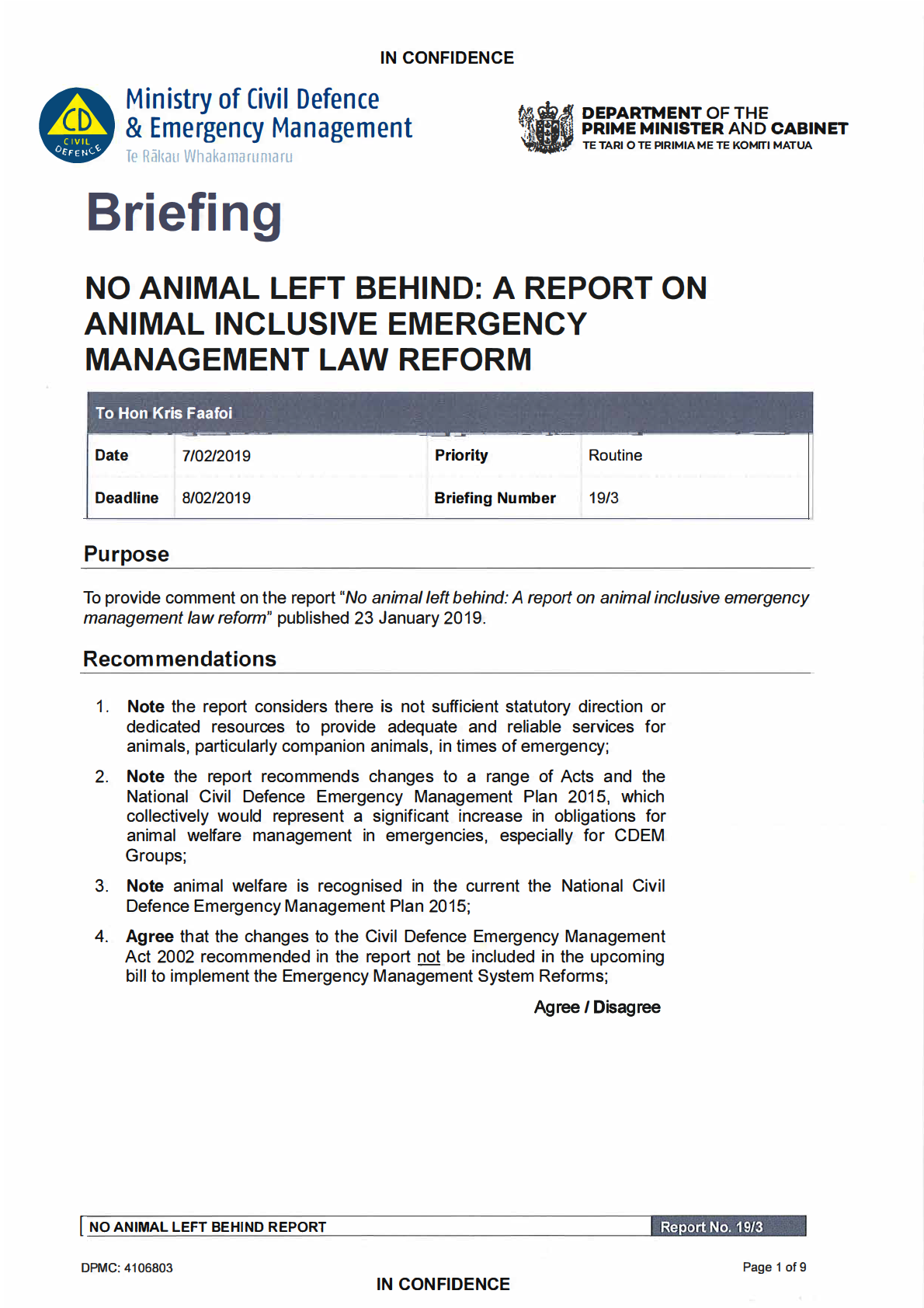
under the Official Information Act 1982
Released

under the Official Information Act 1982
Released
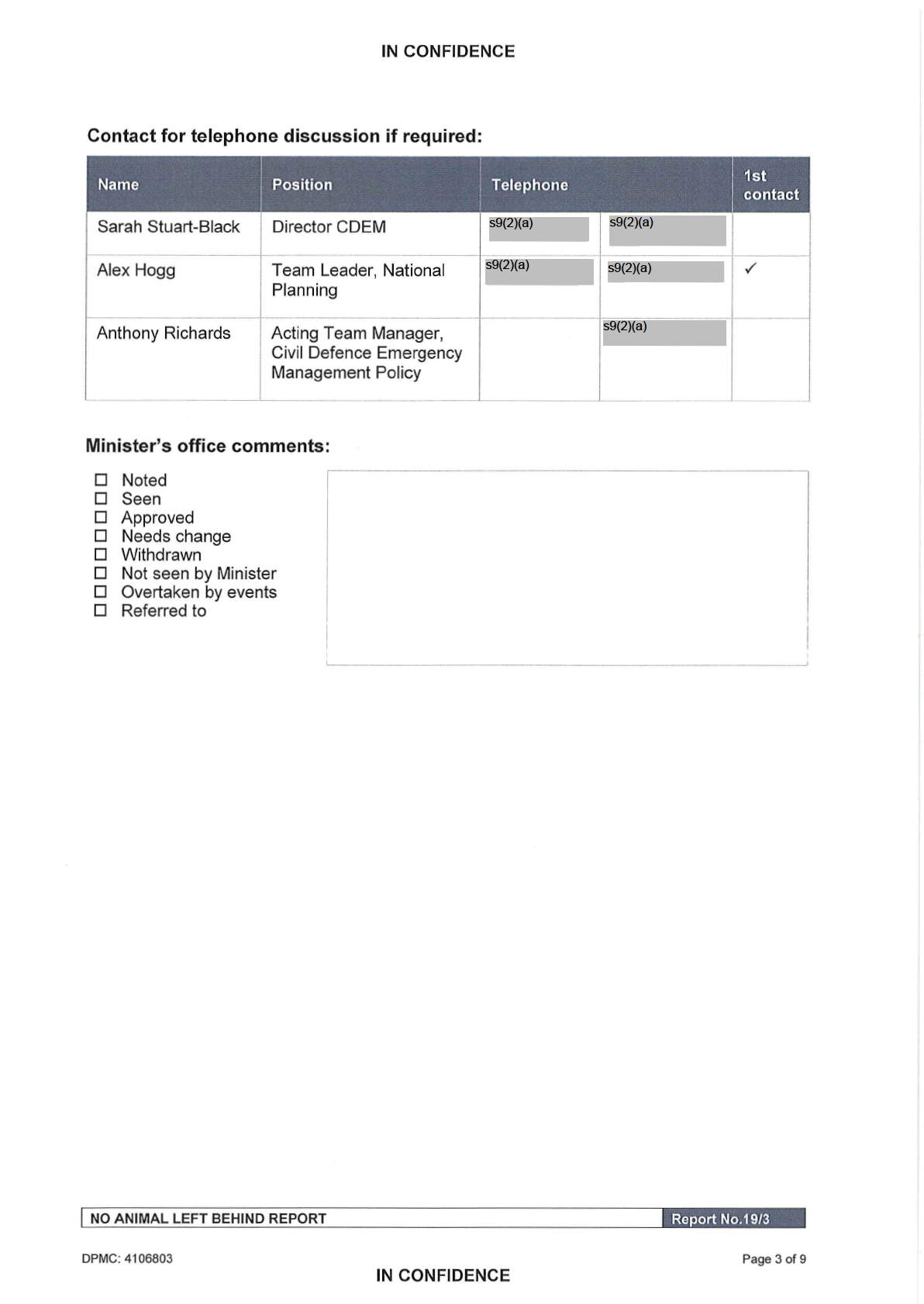
under the Official Information Act 1982
Released
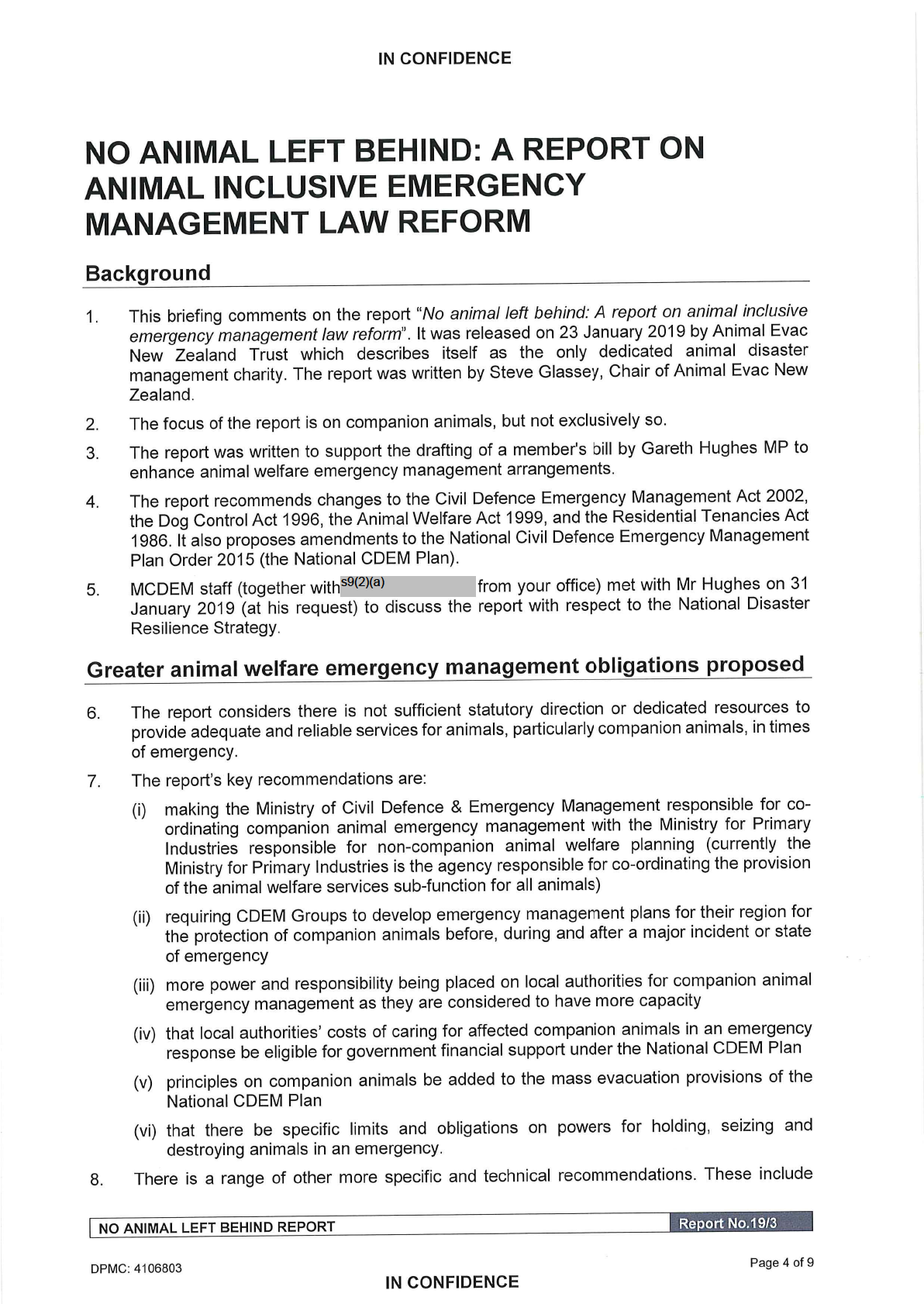
under the Official Information Act 1982
Released
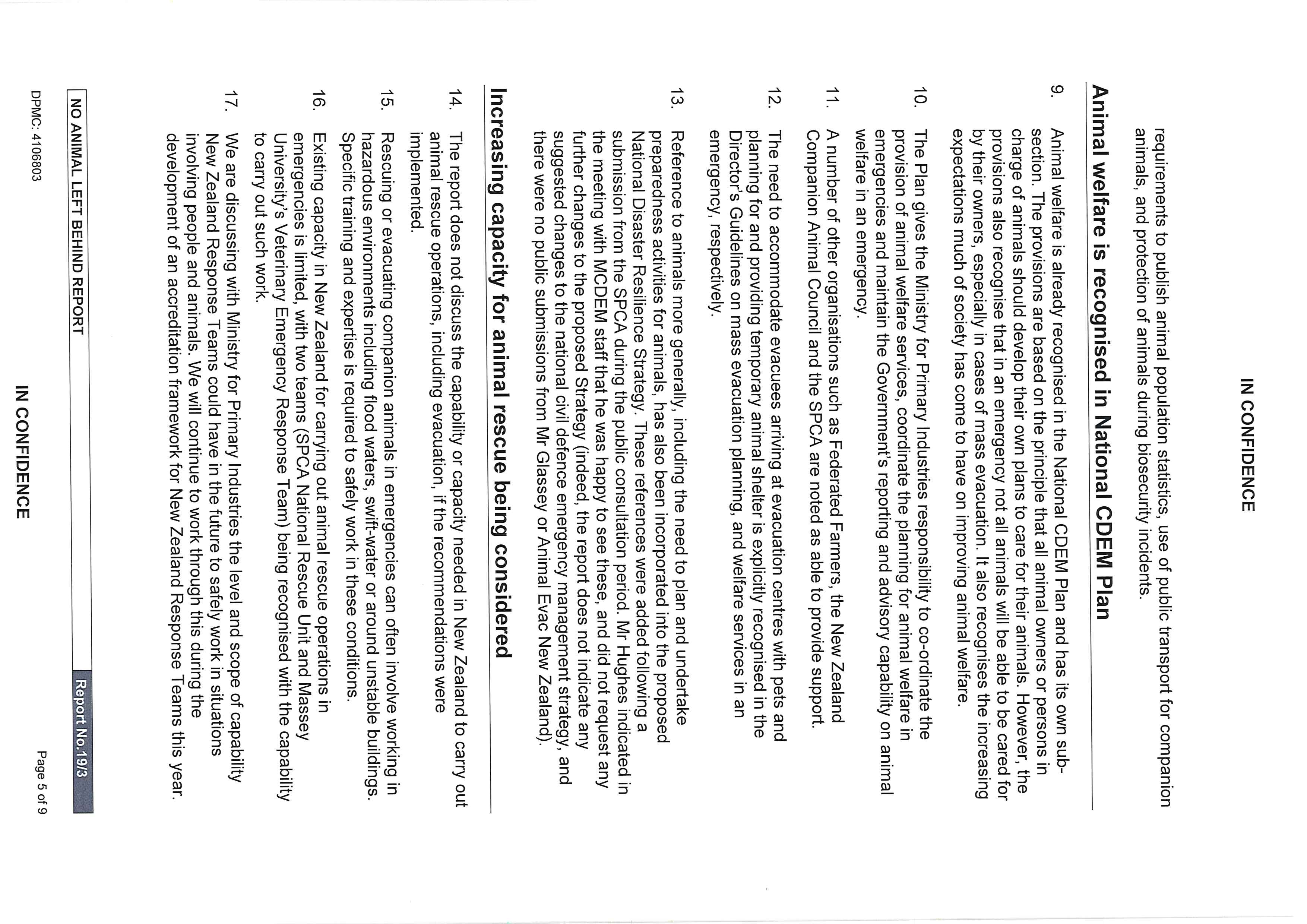
under the Official Information Act 1982
Released
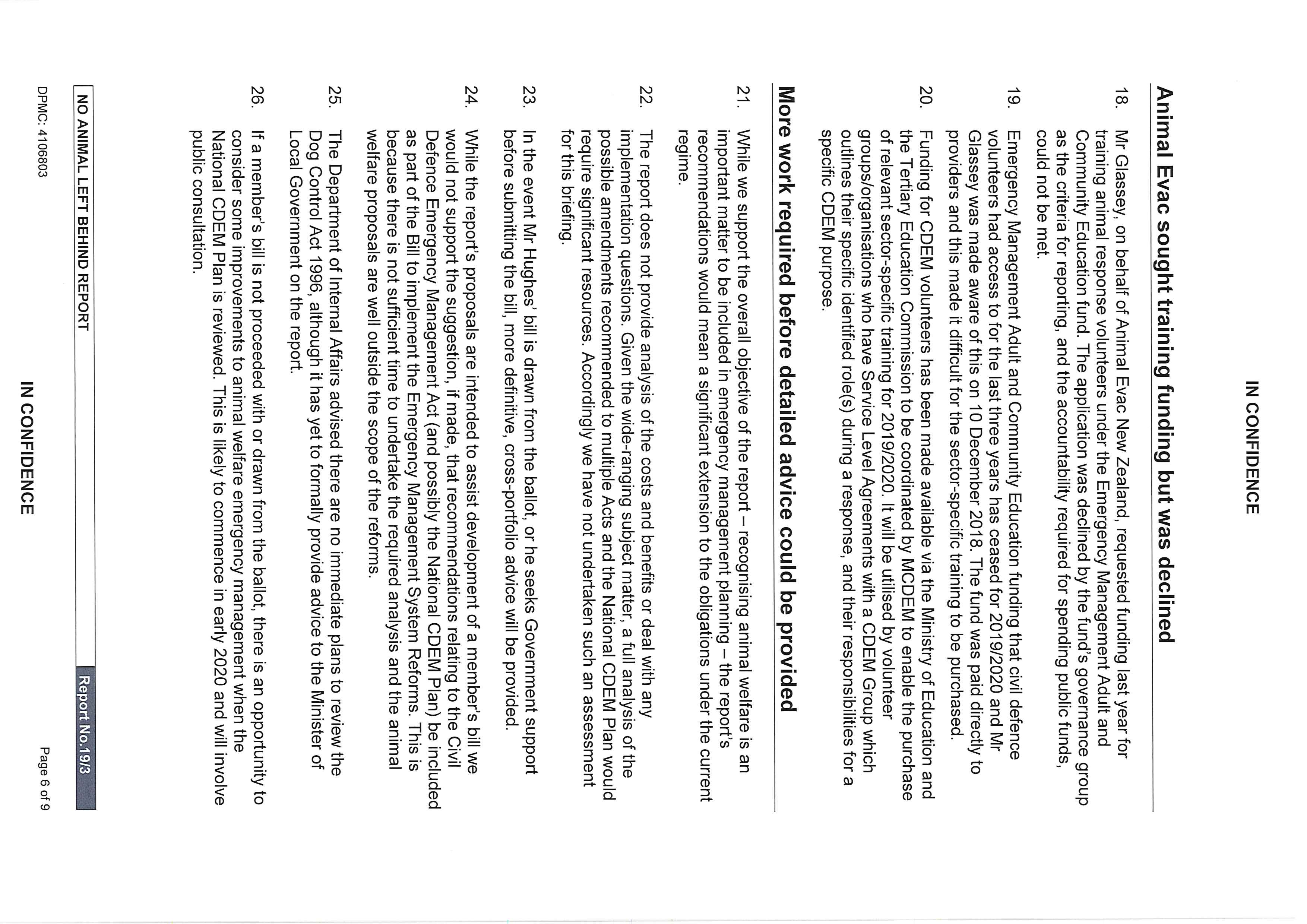
under the Official Information Act 1982
Released
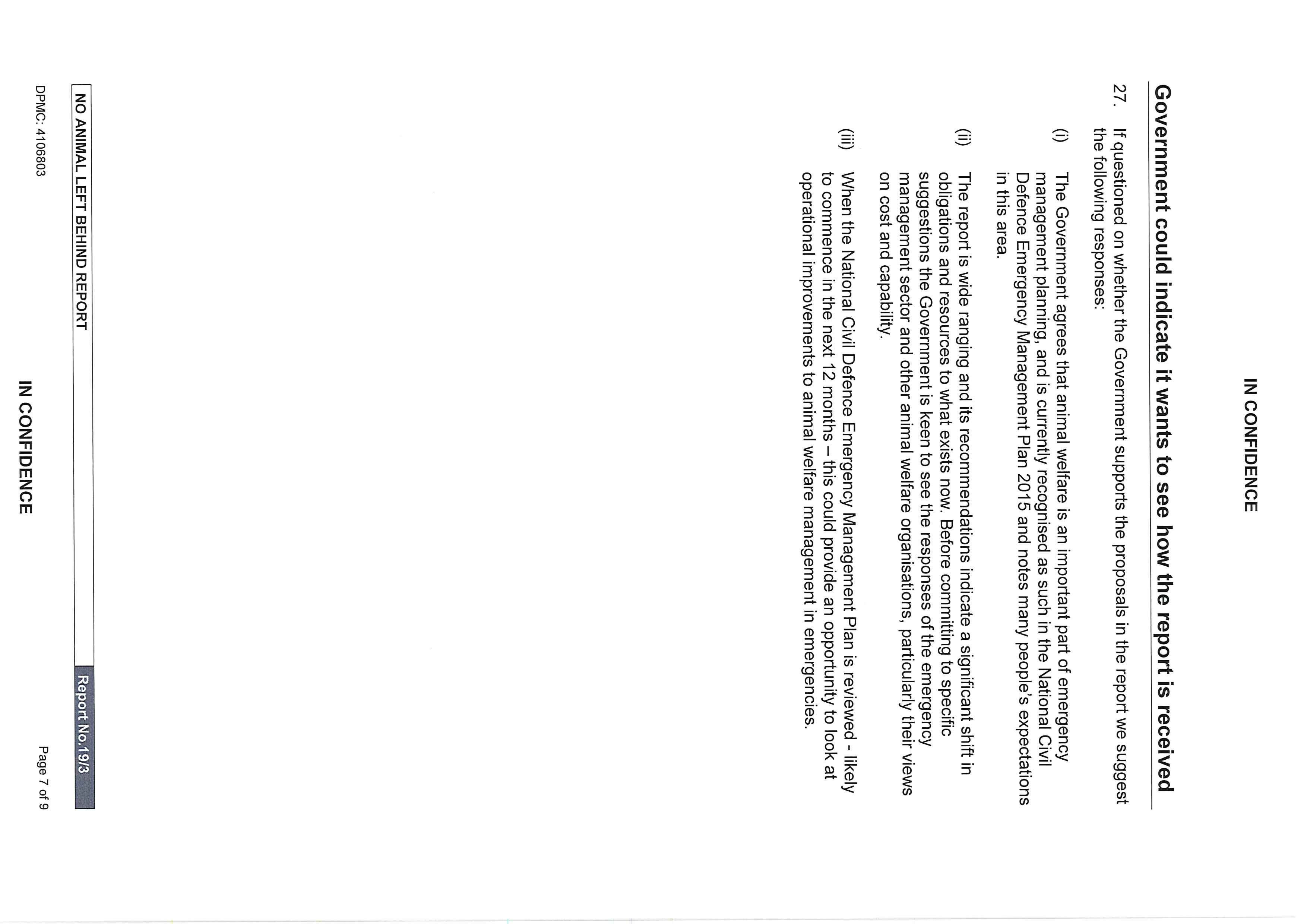
under the Official Information Act 1982
Released
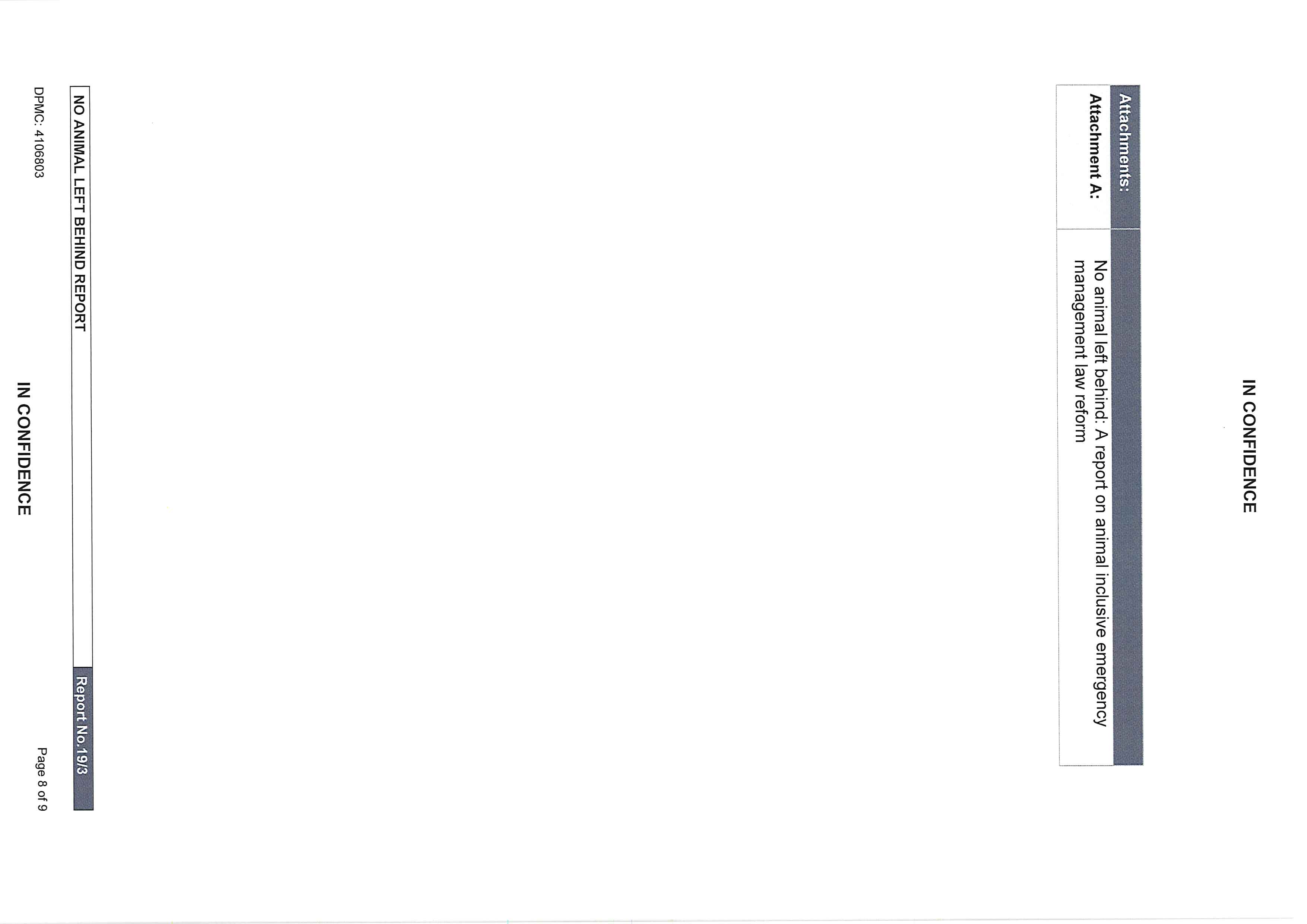
under the Official Information Act 1982
Released

under the Official Information Act 1982
Released
Item 7: Email Chain: Prep for GAC hearing on National Disaster Resilience Strategy
under the Official Information Act 1982
Released
From: Kate Littin s9(2)(a)
>
Sent: Tuesday, 5 March 2019 5:16 PM
To: Alex Hogg [DPMC] <s9(2)(a)
; Anthony Richards [DPMC] s9(2)(a)
Cc: Wayne Ricketts s9(2)(a)
Subject: FW: Prep for GAC hearing on National Disaster Resilience Strategy
Hi both
Thought it might be helpful to share these before we meet in the morning
Talking points – can discuss tomorrow
We also summarised our thoughts on the key recommendations in No Animal Left Behind, in case these points are
raised tomorrow
We’ve not yet worked our way through all of the submissions but will do so before we meet.
See you tomorrow
Kate & Wayne
Kate Littin PhD | Manager Animal Welfare Team
Animal Health & Welfare | Regulation & Assurance Branch
Ministry for Primary Industries | Pastoral House 25 The Terrace | PO Box 2526 | Wellington | New Zealand
Telephone: s9(2)(a)
| MPI tel: 0800 00 83 33 | Mobile: s9(2)(a)
Web: www.mpi.govt.nz
Follow MPI on Twitter (@MPI_NZ) and Facebook
SEEMAIL
__________________________________________________________________________________________________________________
This email message and any attachment(s) is intended solely for the addressee(s)
named above. The information it contains may be classified and may be legally
under the Official Information Act 1982
privileged. Unauthorised use of the message, or the information it contains,
may be unlawful. If you have received this message by mistake please call the
sender immediately on 64 4 8940100 or notify us by return email and erase the
original message and attachments. Thank you.
The Ministry for Primary Industries accepts no responsibility for changes
made to this email or to any attachments after transmission from the office.
__________________________________________________________________________________________________________________
Released
1
MPI talking points – GAC National Disaster Resilience hearing 6 March 2019
Key points
• We note a number of submissions raise points about animal welfare, including that the draft
National Disaster Resilience Strategy should explicitly refer to animals more, and incorporate
a new objective for reform of emergency management.
• This is a high level strategy which already incorporates responsibilities towards animals in
several aspects. This includes referring to saving animal lives in the definition of ‘response’,
and reminders in the document for emergency management plans to include animals.
• In general, the concerns raised in the submissions can be addressed in the work that will
happen under the strategy, and in other local and central government work on emergency
management readiness, response and recovery.
• We don’t believe it hampers forward progress in animal welfare by NOT having a greater
focus on, animal welfare in the draft strategy.
• We believe the outcomes that the submitters are hoping to achieve are able to be achieved
under the draft strategy and under the work programmes already underway to progress
emergency management and animal welfare in emergencies.
Achievements to progress animal welfare to date
• A key achievement that has promoted animal welfare was the legislative change in 2015 that
saw animal welfare recognized as a subfunction of Welfare in the National Civil Defence and
Emergency Management Plan which reflects the role of animals in our society.
• Since then, we see an increased acceptance amongst the CDEM community of the need to
consider animal wel being alongside human and community wel being, supporting the
expectations of New Zealanders that their animals will be taken into account in responses
and recovery. Both of these aspects are best il ustrated by the recent response to the Nelson
Tasman fire, where arrangements were in place for animals to be evacuated, a system was
set up by MPI with support agencies to fol ow up on animals that needed to be left behind,
and animal owners were permitted restricted access to tend their animals where they had
not been evacuated.
• This is supported by good interagency relationships and systems established at central
under the Official Information Act 1982
government level, at a regional level and between MPI and our support agencies.
• New Zealand’s framework for animal welfare in emergency management is considered
world leading, as evidenced by calls for New Zealand to contribute to the development of
policy and research and work programmes overseas.
Work programmes underway
Released
• Planned legislative review being led by MCDEM – MPI is contributing;
• Work programmes to address points raised from previous responses, including the No
Animal Left Behind report, the published outcomes of the Port Hills fires, and lessons
learned from the Kaikoura earthquake, the Edgecumbe flood and experiences from the
recent Nelson/Tasman fire.
• These are being incorporated into MPI’s (the responsible agency for animal welfare in
emergency) workplan and include:
o
Completing regional animal welfare in emergency plans for all 16 regions
o
Developing a regional coordination system
o
Socialising the importance of animal welfare with Civil Defence Groups, and agencies
such as Police, Fire and Emergency NZ, Ministry of Health (in regards to
psychosocial support when animals die/lost/euthanased)
o
Developing information for dealing with animals in different sorts of disasters
o
Considering the development of a nationwide animal rescue capability
o
Responding to animal welfare needs in an emergency – the latest being the Nelson
fire
• There is a gap in who pays for animal welfare in emergencies – both the CDEM Act and
Animal Welfare Act are silent. We are looking at ways how this could be funded – both
legislative and by policy.
• MPI has become a respected responsible agency and the CDEM sector has confidence that
MPI will and does carry out its responsibilities for animal welfare in emergencies.
Background
• DPMC consulted on a draft National Disaster Resilience Strategy last year. MPI made a
submission that supported the Strategy – this was coordinated out of the Readiness team
(BioNZ).
• The Strategy is currently in front of the GAC, to recommend for issue in April. The current
strategy expires 9 April. The strategy is reasonably high level.
• The GAC invited public submissions on the draft strategy in February. Animal Evac
encouraged submissions with content on better incorporating animals into planning, rescue
and recovery at a national level (http://www.animalevac.nz/strategyconsult/ ). We were
unaware of this webpage.
• DPMC reported that the Committee received more than 100 submissions on animal welfare
(of a total of approx. 160). The Animal Evac page encourages reference to the No Animal Left
Behind report. We have initial views on the recommendations in that report.
• The GAC is the select committee that considers civil defence and emergency management
matters. It is chaired by Brett Hudson, National List MP and has a mix of Labour and National
members. Animal Evac is normally supported by Gareth Hughes MP.
• Separately, MCDEM (Ministry for Civil Defence and Emergency Management, part of DPMC)
is writing to Steve Glassey to acknowledge his No Animal Left Behind report, and Minister
Faafoi is writing to Gareth Hughes to thank him for sharing Steve Glassey’s No Animal Left
under the Official Information Act 1982
Behind report, and indicating that MCDEM will work with MPI on the recommendations as it
sees fit.
Released
Notes on key recommendations in No Animal Left Behind
Kate Littin, 4 March 2019
Key recommendation from No Animal Left Behind
MPI initial response
1. The need for companion animal emergency To discuss with CDEM; current animal
management to be led by traditionally human welfare sits as a sub-function of
focused agencies, such as the Ministry of Civil Welfare, which is focussed on human
Defence & Emergency Management at the welfare. This appears to achieve the
national level, and Civil Defence Emergency outcome that is recommended here.
Management Groups at the regional level, as
companion animal emergency management
should be fully integrated with human focused
emergency management as the two were
intrinsically linked.
2. That MPI to be responsible for non-companion We are.
animals such as livestock, factory farms, zoos,
aquariums, and research facilities.
3. A lack of national animal specific emergency Not too sure what the issue is here;
management plans and where plans had been regional plans have ‘legal status’. There
completed at the regional level they had not are regional plans completed or
been afforded any legal status making them underway for all 16 regions, supported
unenforceable.
by MPI.
4. That emergency management laws be We are investigating various legal
expanded to ensure the range of emergency powers with MPI Legal. This is a
powers could also be used for the protection of significant and complex issue and
animals, including adding microchipping of involves powers under a number of
animals as an emergency power.
different Acts.
5. Providing clear mandate for the rescue and We consider this is best addressed
under the Official Information Act 1982
decontamination of animals, and that such under regional CDEM plans (the
operations fall under Fire & Emergency New specifics) and at a national level by work
Zealand, to ensure human and animal rescue we are doing with FENZ. We consider
operations were better integrated.
that there is a role for agencies other
than FENZ (eg Police).
6. Emergency response and training funding for We agree wholeheartedly; we are
animal welfare be made available, rather than waiting on MPI Legal advice on some
Released
having the good will of animal charities be specific aspects, and have been working
exploited.
with MCDEM on funding for training.
7. That the two national microchipping database This is a specific point that can be picked
are enabled to share data, in particular during up at a regional level in regional plans,
emergencies to ensure improved reunification but requires agreement to at a national
rates.
level by individual CDEM groups – which
has previously not been agreed.
8. Creating an offence for placing service dog A specific point we are considering for
identification on dogs that are not certified as our work programme.
disability assistance dogs; and another offence
for failing to protect animals from hazards such
as floods, fires etc where it is reasonable to do
so.
9. Ensuring commercial operators of animal Agree. Requirements for contingency
housing facilities have documented emergency planning are laid out in the code of
management plans in place that are tested.
welfare for temporary housing, issued
under the Animal Welfare Act in 2018.
10. That local authorities need to ensure they have Agree in principle that this may be
provisions in their bylaws to allow for necessary – to be considered whether
emergency
variations
to
dog
control MPI needs to do anything specific about
ordinances such as designating emergency dog this recommendation.
exercise areas.
11. That the legal processes for entry onto For MCDEM consideration.
property to carry out rescue of animals,
including seizure, notification to owners and
disposal, including rehoming be amended as
the current laws fail to provide for rehoming of
animals seized under civil defence legislation as
disposal provisions were omitted.
12. That the National Animal Welfare Advisory NAWAC can have specific expertise in
Committee expand their prescribed expertise this regard if necessary; it has previously
to including animal disaster management given received this advice from external
the demands of climate change.
consultants and a national board
(NAWEM). We do not agree that this
should be a statutory requirement.
13. That following a disaster in the statutory For MCDEM and regional CDEM plans.
under the Official Information Act 1982
recovery transition period, those seeking rental
accommodation cannot be discriminated
against for owning companion animals to
ensure the family unit can remain together.
14. That civil defence no longer have the This needs to be worked through with
autonomous power to destroy animals in a MCDEM; we are not sure this is
Released
disaster, with new requirements to consult necessary, although would agree with
with an animal welfare inspector should this the outcome that appropriate decisions
option be pursued.
are made and that euthanasia is carried
out in accordance with the Animal
Welfare Act.
15. That a new Code of Emergency Welfare be The National Animal Welfare Advisory
introduced to provide minimum standards for Committee will be advised of this
animals during times of emergencies as recommendation (at the moment, it is
standard Codes of Welfare often are not aware of the recommendation but has
enforceable during times of emergency.
not received advice on it from MPI).
16. That animal population data is developed and Agree. MPI has this on its 2018/19 and
maintained for emergency planning purposes.
2019/20 work programme.
17. That companion animals be permitted on Presumably civil defence powers can allow
public transport to aid their evacuation during this. MCDEM will need to consider this
emergencies.
recommendation.
under the Official Information Act 1982
Released
Item 8: Email Chain: Subs Summary for GAC 6 March
under the Official Information Act 1982
Released
From: Kate Littin s9(2)(a)
>
Sent: Wednesday, 6 March 2019 2:11 PM
To: Anthony Richards [DPMC] <s9(2)(a)
Subject: Fwd: Subs summary GAC 6 March
As discussed
Sent from my iPhone ‐ please excuse brevity
Begin forwarded message:
From: Kate Littin s9(2)(a)
>
Date: 6 March 2019 at 7:32:07 AM NZDT
To: Wayne Ricketts s9(2)(a)
>, Chris Rodwell <s9(2)(a)
>
Subject: Subs summary GAC 6 March
Morning
My notes attached on submissions to GAC on the draft National Resilience Strategy – to discuss
today
Wayne – be keen to hear your thoughts on SPCA sub this morning
Kate
Kate Littin PhD | Manager Animal Welfare Team
Animal Health & Welfare | Regulation & Assurance Branch
Ministry for Primary Industries | Pastoral House 25 The Terrace | PO Box 2526 | Wellington | New Zealand
Telephone s9(2)(a)
| MPI tel: 0800 00 83 33 | Mobile: s9(2)(a)
| Web: www.mpi.govt.nz
Follow MPI on Twitter (@MPI_NZ) and Facebook
SEEMAIL
under the Official Information Act 1982
__________________________________________________________________________________________________________________
This email message and any attachment(s) is intended solely for the addressee(s)
named above. The information it contains may be classified and may be legally
privileged. Unauthorised use of the message, or the information it contains,
may be unlawful. If you have received this message by mistake please call the
sender immediately on 64 4 8940100 or notify us by return email and erase the
original message and attachments. Thank you.
Released
The Ministry for Primary Industries accepts no responsibility for changes
made to this email or to any attachments after transmission from the office.
__________________________________________________________________________________________________________________
1
In confidence - Doc for internal MPI discussion
AW submissions to GAC Feb 2019
General response
A call needs to be made whether to highlight animals more in the wording of the strategy;
Otherwise the strategy already seems to enable the outcomes that are being sought in the
submissions;
Majority of individual animal welfare subs appear to be made without reading the draft strategy.
Animal Evac recommendations:
• The GAC invited public submissions on the draft strategy in February. Animal Evac
encouraged submissions with content on better incorporating animals into planning, rescue
and recovery at a national level (http://www.animalevac.nz/strategyconsult/ ).
“I/we believe that specific, measurable and accountable objectives to better protect animals in
future emergencies will save human life, as well as that of improving animal welfare in such
events.
Under I/we would like to make the following recommendations:
Specific goals should include implementation of the recommendations made by Animal Evac
NZ’s report on animal disaster management presented at Parliament in January 2019.
An additional section under
4.4 Resilience and people disproportionately affected by
disaster; namely
4.4.5 Animals and Community
People often have strong bonds with their animals which can influence their behaviour in
emergencies. Research and experience show that if animals are not protected during
under the Official Information Act 1982
emergencies that owners will often place themselves at risk to do so. Production animals are a
key element of our economy and losses of such animals has economic and trading reputation
impacts. This strategy commits to enhancing laws and arrangements to better protect animals
from disaster, and by doing so protect human life and contribute to great levels of resilience.
Add Strategy Objective 19:
Implement world leading animal disaster management reform to better protect companion
and production animals in particular, including improvements to laws, funding, plans and
Released
capabilities.”
Summary of submissions on animal welfare
Name
Comments
Response
Carley Ferris
Need specific animal disaster management goals;
Ok but animals can be promoted without this
US has PETS – we need the same;
Need specific, measurable and accountable objectives to better
protect animals to save human and animal lives
Should include implementation of Animal Evac report
Detailed work programme not resilience strategy
recommendations
4.4 Resilience and People – add new section re animals [text
Ok but animals can be promoted without this
provided]
Insert new Strategy Objective 19 [text provided – implement world
Above and this work is underway
leading animal disaster management reform…]
Carole Adamson
Needs explicit recognition of animal link with
individuals/communities/families (eg Nelson fires)
Strategy should consider inclusion of animal welfare and animal
welfare orgs as fundamental components of resilience
HUHA
No specific comments on Resilience Strategy
Julie Duncan
No specific comments on Resilience Strategy
Should include implementation of Animal Evac report
recommendations
Julie Duncan – additional
No specific comments on Resilience Strategy
note
Lisa Praeger
AE recs
Raewyn Cowie
Specific recs to include animal welfare/provisions eg ‘felony’ to
All points possible under current law
abandon animals
SAFE
Verbatim AE recs
under the Official Information Act 1982
Soala Wilson
Have an animal disaster plan
General comment from AE
Vivienne Wright
General comments on including animals
Released
Concern at lack of transparency (presumably relating to comments
about closed consultation)
Wendy Gray
AE recs
SPCA
Specific recommendations to incorporate reference to animals as
Could be used to incorporate some references to
part of society, and explicitly recognise them in planning etc
animals if the Committee wanted to;
Seems like desired outcomes can already be met
under current draft.
Susan Elliott
AE recs
Otago CDEM
‘Planning for animal welfare before, during and after emergencies
must be explicitly embedded in the strategy’
Dog Share Collective
No specific comments but supports community approach in strategy
Ann-Marie Lynch
AE recs
Cathy Bruce
General comments
AE recs
Cheryl Easton
AE recs
Claire Hatfield
Suggests take recs from recent AE report
Jo Spence
AE recs
Joan Oxlee
AE recs
Angelika Sansom
AE recs
Emma Roache
Suggests take recs from recent AE report
Helen McGowan
General comment that animals need to be considered/rescued
Katherine Walsh
AE recs
Manako Sugiyama
AE recs
Maria Gray
General comment that animals need to be considered/rescued
Natasha Parshotam
General comment that animals need to be considered/rescued
Sandra Toomer
General comment that animals need to be considered/rescued
Rose Guscott
General comment that animals need to be considered/rescued
Theresa Parkin
Suggests take recs from recent AE report
under the Official Information Act 1982
Sharon Kirk
AE recs
Emily Brewer
General comment that animals need to be considered/rescued
James Chin
AE recs
Released
Kimberly Schick-
General comment that animals need to be considered/rescued
Puddicombe
Maria Cawdron
General comment that animals need to be considered/rescued –
animals are family too
Nancy Higgins
AE recs
Sandra Munro
General comment that animals need to be considered/rescued
Kia Barnes
General comment that animals need to be considered/rescued
Sarah Lodge
AE recs
Trudy Burgess
AE recs
Animal Evac
SG report No Animal Left Behind
Animal Evac
General comments
Animal Evac
AE recs
Russell Black
General comments to evacuate with animals etc
46 individual subs
General comment that animals need to be considered/rescued
Or AE recs
Glen George
Personal comment/anecdotes from Nelson fires
(Approx 82 total on AW
indiv subs)
(5 organisation subs)
under the Official Information Act 1982
Released

































